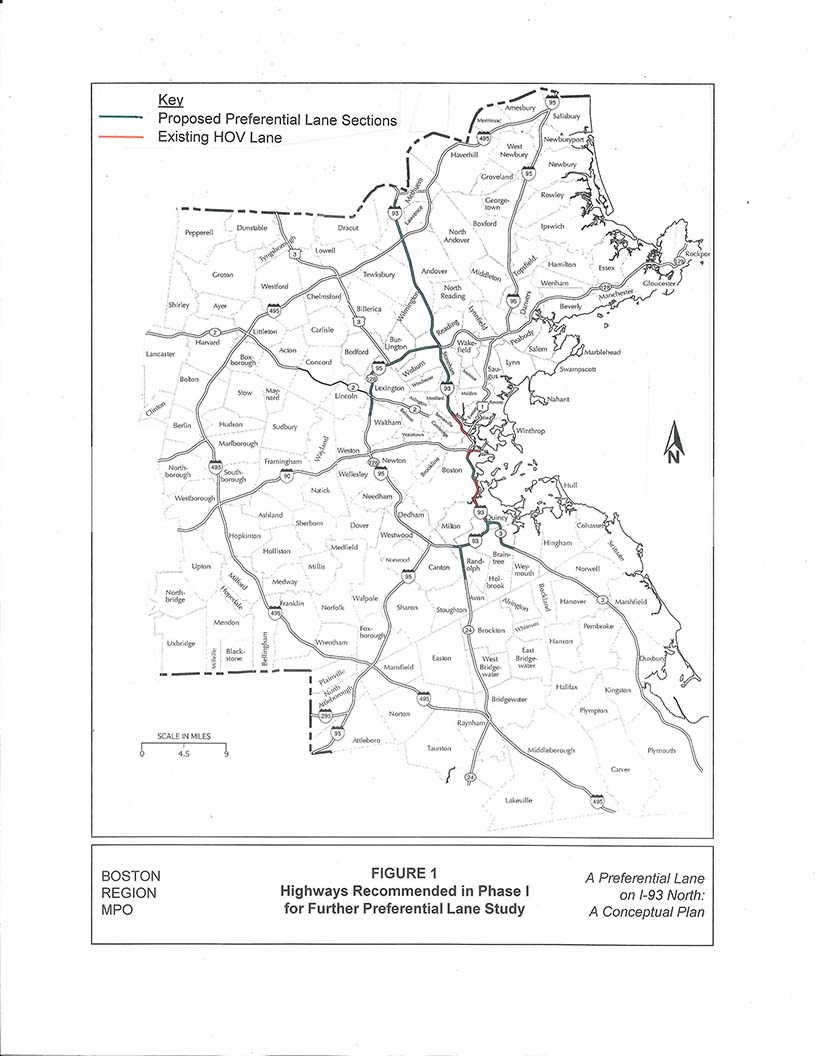
Memorandum
Date April 3, 2014
To Boston Region Metropolitan Planning Organization (MPO)
From William Kuttner, MPO Staff
Re A Preferential Lane on I-93 North: A Conceptual Plan
The MPO’s Phase I Regional HOV Lane Systems Planning Study1 surveyed all of the limited-access highways in eastern Massachusetts to identify suitable locations for implementing high-occupancy vehicle (HOV) facilities. Interstate 93, both north and south of Boston, emerged from this screening process as a site with the greatest potential to realize substantial user benefits from an HOV lane system. Some limited HOV facilities already have been built on portions of I-93; and the Phase I Study recommended studying the possibility of extending or integrating these existing facilities to form a more complete system.
In this Phase II Study, staff considered expanding HOV facilities north of Boston on a conceptual level. The Phase I Study found that adding a reversible “preferential lane”—limited to vehicles such as HOVs or toll-paying autos—along any portion of roadway between the New Hampshire border and the northern end of the existing, southbound-only HOV lane at the Medford-Somerville border, could offer user benefits. The study further showed that these benefits would be greatest on the sections of I-93 closer to Boston.
This study begins by using knowledge of regional traffic patterns and the calculations of the Phase I Study to recommend a basic network configuration of a new preferential lane system. Several physical constraints in the northern-most part of I-93 are identified in the study; and the northern terminus of the system is placed in Andover, more than a mile south of I-495.
The proposed system is comprised of three new reversible preferential lane sections: the northern section between the northern terminus and a point north of the I-93/I-95 interchange in Woburn, a central section passing through the interchange to a point south, and a southern section extending to the vicinity of the existing, southbound-only HOV lane. Users of these preferential lane sections must enter and leave at the section endpoints. The location and extent of the three sections have been chosen to maximize user benefits.
The Boston MPO regional travel demand model was used to estimate travel time savings for the preferential lane system. Model results showed travel times decreasing during AM and PM peak periods in both the general-purpose and the preferential lane sections, with the preferential lane improvements exceeding those of the general-purpose lanes.
A requirement of both the Phase I and II studies was that all users of the improved highway must benefit in order for the preferential-lane implementation to be considered feasible. A greater benefit to preferential-lane users is an incentive for users to meet the eligibility requirement, whether it is occupancy, toll payment, or other criteria. Improvement in the general-purpose lanes is assumed necessary to build public support for a major investment. Another major beneficiary of this investment would be users of the expanding regional bus services, though this travel market was not reflected in the travel model.
While the proposed preferential-lane system, as configured, is shown to offer significant user benefits, its structural feasibility and cost-benefit ratio remain to be determined. In addition, physical design concepts that can realize these benefits while minimizing right-of-way requirements, environmental impacts, and construction costs must be specified and explored. We hope this study would play a catalytic role in beginning the process to identify how a preferential-lane system might be designed to conform to established standards.
This study proposes a system of three 28-foot wide reversible-lane segments that would extend between their respective entry-exit sections. We suggest locations and possible design alternatives for the entry-exit sections, whose placement is critical to realize projected user benefits and safe traffic operations.
MassDOT and its I-93/I-95 project consultant have reviewed this initial conceptual plan. Their comments, which are cited in Appendices A and B, point to approaches and structural-feasibility issues that need to be addressed during design in order to realize anticipated user benefits and justify the investment. There are a number of variants of this initial conceptual plan that would be considered in any subsequent study phase.
This memorandum summarizes the findings of Phase II of the Regional HOV-Lane Systems Planning Study, which builds upon recommendations of the Phase I Study. The Phase I Study assembled traffic and congestion information for all express highways in the 164-municipality Boston Region MPO travel demand model region. After applying screening criteria uniformly across the entire express highway system, the Phase I Study concluded that only a few sections of the regional express highway system were suitable for implementing a preferential lane, such as lanes restricted to high-occupancy vehicles (HOVs), or perhaps to vehicles paying a toll. The regional express highway system and sections identified for further study are shown in Figure 1.
The recommended highway sections highlighted in Figure 1 are mostly on I-93, and cover most of its length. The close-in portions of Routes 24 and 3 on the south that connect with I-93 are also candidates for further study, as is the northwest arc of the I-95/Route 128 circumferential highway. Several HOV facilities serving I-93 currently exist; and extending the HOV lanes south of Boston was the subject of a recent study.2
The Phase II Study focuses on I-93 north of Boston, and proposes a system extending north from the vicinity of the existing north-side, southbound-only, HOV facility, as shown in Figure 2. In this memorandum, we first review how the existing HOV lane was implemented and improved, including the associated regulatory issues. Next, we discuss how I-93 north emerged from the Phase I screening process and how the proposed system extent extension shown in Figure 2 came to be recommended.
Then, we describe the overall configuration and envisioned operations of the proposed system, emphasizing the placement and use of the entrances and exits of the three sections. Next, we present the projected travel time savings estimated by the MPO’s regional travel demand model set.
In the section that follows, we present and analyze design standards, feasibility, and construction issues for the entire corridor. Importantly, we show how the relevant design standards can be accommodated within the study area—a key requirement of feasibility. Finally, we qualitatively assess construction costs in the study area, and conclude that no construction challenges appear insurmountable.
Figure 1
Highways Recommended in Phase I
for Further Preferential Lane Study

Figure 2
Proposed Sections of I-93 North
Preferential Lane System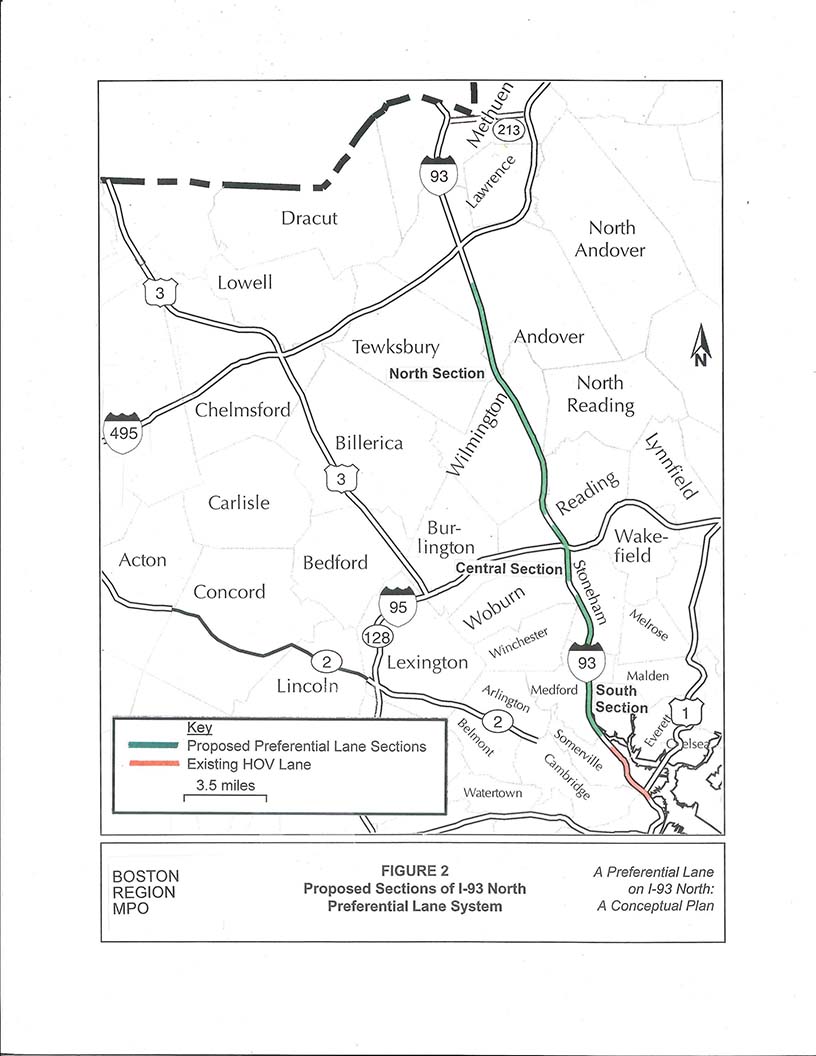
Interstate 93 was the last express highway constructed that connected the suburbs to downtown Boston. It was also the first highway in the region to dedicate a lane for the exclusive use of HOVs. Originally, I-93 was to be one of several freeways that would have penetrated Boston’s urban core. These radial freeways would have met the then-planned I-695, known as the “Inner Belt,” which was to loop westwards from I-93 at Sullivan Square, and after passing through Cambridge and Roxbury, connect again with I-93 in the vicinity of today’s Massachusetts Avenue interchange.
In the late 1960s, in response to strong opposition to further freeway construction in Boston’s urban core, Governor Francis Sargent stopped the work then underway on the urban freeways and empanelled the Boston Transportation Planning Review (BTPR) to reconsider the existing transportation agenda. Cancelling the Inner Belt expressway was one of the recommendations of the BTPR, which became the policy of the Sargent, and later the Dukakis, administration.
At the time the BTPR was organized, I-93 had been completed only as far south as the Mystic Avenue Interchange 30 ramps at the Medford-Somerville town line. The BTPR process did not cancel the completion of I-93, but the elimination of the Inner Belt did present a serious design problem. At that time, I-93 passed through downtown Boston on the elevated Central Artery, crossing the Charles River on the so-called “High Bridge.” Following a pair of local ramps in Charlestown, Central Artery traffic connected with US 1 and the Tobin Bridge.
The High Bridge was a two-level structure with three lanes in each direction, matching the three lanes each way on the Tobin Bridge. If I-93 were extended south from Mystic Avenue, all the southbound I-93 traffic would need to merge with the three lanes of Tobin Bridge traffic as it entered the three-lane High Bridge. Despite a clear appreciation of the imminent bottleneck, the decision was made to extend I-93 from Mystic Avenue to the High Bridge and wrestle with the bottleneck upon completion of I-93.
This last link of I-93 was opened in September, 1973. The plan that emerged to address the bottleneck included an HOV lane, which opened on the lower deck of I-93 in February, 1974. After construction of the HOV lane, there remained only two southbound general-purpose lanes approaching the High Bridge. The approach from Tobin Bridge was re-striped down to two lanes. Traffic from the four general-purpose lanes from I-93 and Tobin Bridge and the HOV lane needed to squeeze into the three lanes of the High Bridge until the Zakim Bridge was completed a quarter century later.
As traffic shifted to I-93 after its opening, southbound queues on the lower deck of the newly completed I-93 section steadily lengthened. This required the HOV lane also to be lengthened so that access to the lane would not be blocked by the peak period queue. It was lengthened in August, 1974, and again in October, 1979, at which time it extended to the vicinity of Sullivan Square, near the start of the double-decked structure.
Initially the HOV lane was limited to carpools with three or more riders and buses, but allowed general traffic destined for US 1, traveling either to the Tobin Bridge or exiting at Charlestown. A station for enforcing HOV lane occupancy was located after the US 1 exit. The beginning of construction of the Central Artery North Area (CANA) project necessitated closing the southbound move to US 1, and with only buses and carpools with three or more riders, the HOV lane was clearly underutilized. In 1988, eligibility was relaxed to allow carpools with two or more riders, the rule in effect today.
By 1990, as the Central Artery/Third Harbor Tunnel (CA/T) project was being planned, the southbound AM peak-period queue on I-93 began near the Mystic Avenue interchange, a mile and a half before the entrance of the HOV lane at Sullivan Square. It was apparent that a further extension of the HOV lane should be considered, and MassDOT (at that time the Massachusetts Highway Department, or MassHighway) agreed to extend the HOV lane as one of a large number of environmental mitigation commitments.
Extending the I-93 HOV lane became a legal requirement3 pursuant to the completion of a feasibility study. This regulation imposed several conditions:
The Feasibility Study4, however, also considered the possibility of providing an HOV lane in some manner all the way to I-95/Route 128. The Feasibility Study developed three recommendations:
The HOV lane was extended as required and recommended. The entrance is now about one-third mile south of the ramp viaduct of Interchange 30 at Mystic Avenue. As many as 800 vehicles per hour during the AM peak period, including about 28 buses, use the lane5 .
The Phase I Study had several planning criteria by which all parts of the regional express highway system were evaluated and that informed consideration of an expanded preferential lane system. These planning criteria were:
As Figure 1 shows, the Phase I Study recommended only a few of the regional express highways for further consideration as part of a regional preferential lane system. Suitable parts of the express highway system needed to be in the user benefit “sweet spot,” where general-purpose vehicles would receive a travel time benefit, but preferential lane users would realize a greater benefit. Also, given the need to reconstruct highways to accommodate an added reversible lane, at some locations the benefits did not appear to merit what appeared to be a very difficult construction challenge.
I-93 and several of its connecting highways best satisfied the criteria that were used in the Phase I Study. South of Boston, the Southeast Expressway Study and other planning efforts have looked at adding HOV, bus-only or preferential lane-type facilities. For this reason, the Phase II Study is focusing on I-93 north of Boston.
One finding of the Phase I Study was that Interchange 27 at Winter Street/Totten Pond Road in Waltham serves a large regional employment center. There are strong AM and PM directional traffic flows between Waltham and I-93 that might be served by a reversible preferential lane. This potential system element is not the subject of this study, but nothing proposed in this study precludes implementing a preferential lane on the I-95/Route 128 northwest arc.
It is interesting to consider the three Phase I planning assumptions with respect to the Feasibility Study of almost twenty years earlier:
The Feasibility and Phase I studies were undertaken in two completely different contexts. In the first, MassDOT had agreed to extend an existing HOV lane but sponsored a study that looked at both the required improvement as well as the potential for a more extensive HOV implementation. The Phase I Study compared a large number of dissimilar express highways across eastern Massachusetts and, by uniformly applying criteria, identified promising opportunities for preferential lane implementation. Given the different motivations for the two studies, it is reassuring that in important respects the two studies reinforce each other.
The Phase I analysis determined that with current levels of traffic, a preferential lane could provide traffic flow benefits on I-93 to the northern boundary of the study area at the New Hampshire state line. The benefits were more compelling for those portions of I-93 closest to Boston, but even the section near New Hampshire met the user benefit criteria employed in the Phase I Study.
We would expect user benefits in the northern part of the system to increase in the future as a result of secular growth in regional traffic, a trend accentuated by the planned widening of I-93 in New Hampshire. Even if the breakdown lanes north of Interchange 41 at Route 125, which are used as travel lanes during peak periods, were upgraded to full-service fourth lanes, the preferential lane system still would provide some traffic flow benefit at its northern end, both now and in the future. No upgrade of the breakdown lanes in this area is planned, however.
Design recommendations in the Phase I Study were very limited. In the case of the northern terminus of an I-93 preferential lane system, the study suggested that for practical reasons, the logical northern end would be in Methuen between Interchange 46 at Routes 110/113 and Interchange 47 at the entrance of the collector/distributor (CD) system that serves the limited-access Route 213, as shown in Figure 1. (See Figure 2 for Route 213 designation.) The Phase I Study also suggested that the existing Merrimack River Bridge could accommodate the new reversible lane if the breakdown lanes were converted to fourth travel lanes over the bridge.
The Phase I Study considered the Merrimack River Bridge to be the narrowest cross-section within which the envisioned 4+1+4 lane configuration could be implemented, even for a limited distance. The planned reconstruction of the problematic Interchange 46 at Routes 110/113 just north of the Merrimack River Bridge would result in a reconstructed I-93 cross-section slightly narrower than the bridge—in effect precluding inclusion of a reversible lane without another round of reconstruction.6
Given the existing and proposed highway design parameters in the northern-most part of the I-93 corridor in Massachusetts, the Phase II Study recommends that a new preferential lane system could extend as far north as Interchange 43 at Route 133 in Andover, a little more than a mile south of I-495 as Figure 2 shows. This distance from I-495 provides ample weaving distance for vehicles using the preferential lane to weave to or from the nearest I-495 ramps. Multi-lane weaving distances are an important factor in the design of the proposed preferential lane system because no ramps serving the reversible lane directly were recommended in the study.7
Figure 2 shows the three proposed preferential lane sections, northern, central, and southern. These three reversible lane sections are envisioned to be fully separated from adjacent general-purpose lanes. Vehicles using the preferential lane system will only be able to enter or exit at the ends of the three sections. Two of these “entry-exit sections” are shown just north and south of I-95/Route 128, dividing the reversible lane system into three parts.
The two entry-exit sections at the ends of the central reversible lane section allow preferential lane users in the north or south sections sufficient weaving distance to reach the ramps that connect with I-95/Route 128. Similarly, the northern end of the northern section is situated in Andover, at a point that allows safe weaving for traffic wishing to connect with I-495.
The initial review of peak-period ramp volumes on I-93 clearly indicated that traffic connecting with the two interstate beltway systems greatly exceeded traffic at other interchanges. Consequently, the recommended locations of entry-exit sections allow for convenient access to the two circumferential interstates; and vehicles entering at other locations will need to use the general-purpose lanes until reaching the nearest entry-exit section.
Figures 3 and 4 present in schematic format the proposed preferential lane system. Figure 3 shows existing and proposed southbound lanes and ramps as they would be utilized during the AM peak period. Figure 4 presents similar information for the northbound direction during the PM peak period. The 2010 AM and PM peak-hour volumes are shown on Figure 5.
In Figure 3, southbound traffic is shown as entering the system at the far left, just north of Interchange 43 at Route 133. At this point, general-purpose traffic is allowed to use the breakdown lane during the AM peak period. These so-called “managed lanes” are generally used by fewer vehicles than are full-service lanes; and upgrading to a full-service lane would be considered a capacity increase.
The entrance of the reversible lane is shown in Figure 3 as positioned among the cloverleaf ramps of Interchange 43. The entrance would be south of the Route 133 viaduct that crosses I-93, thereby eliminating any need to reconstruct this viaduct. Placing the reversible lane entrance at this point precludes use of this preferential lane section by Route 133 traffic.8
Implementation of a reversible lane would require varying degrees of highway reconstruction over the length of the envisioned system; and in the course of reconstruction it is possible that a full-service fourth lane would be added in this area. The Phase I analysis concluded that the preferential lane would provide user benefits on I-93 even with a fourth full-service lane. Since there are no firm plans at this time to provide a full fourth lane, Figure 3 shows the existing managed lane still in service within the proposed preferential lane system.
Southbound vehicles entering the preferential lane at Interchange 43 would need to stay in the lane all the way to the end of the northern section at
[back of Figure 3]
FIGURE 3
Southbound: Existing and Proposed Lanes, Ramps, and
Reversible Preferential Lane
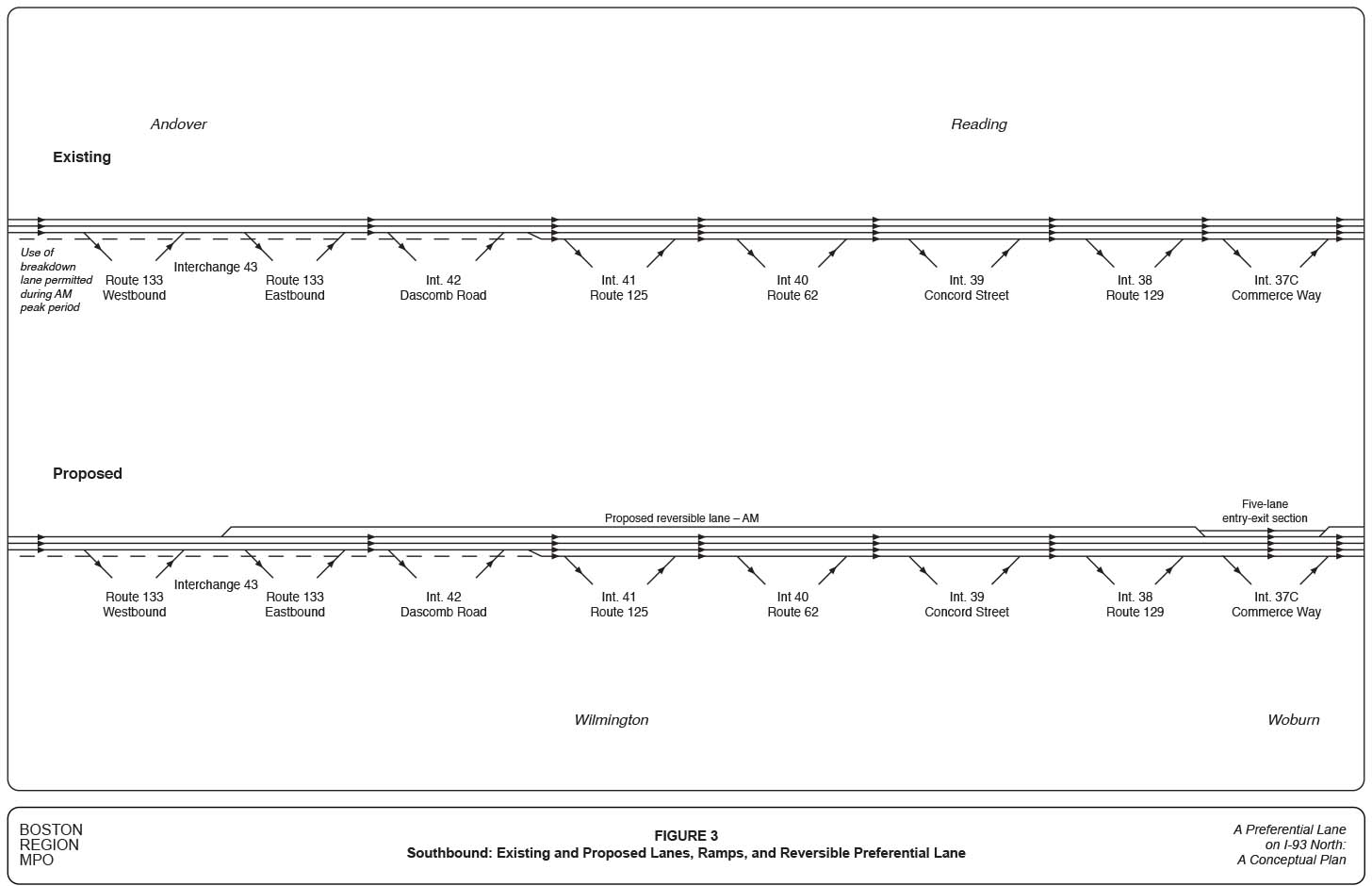
FIGURE 3 (continued)
Southbound: Existing and Proposed Lanes, Ramps, and
Reversible Preferential Lane
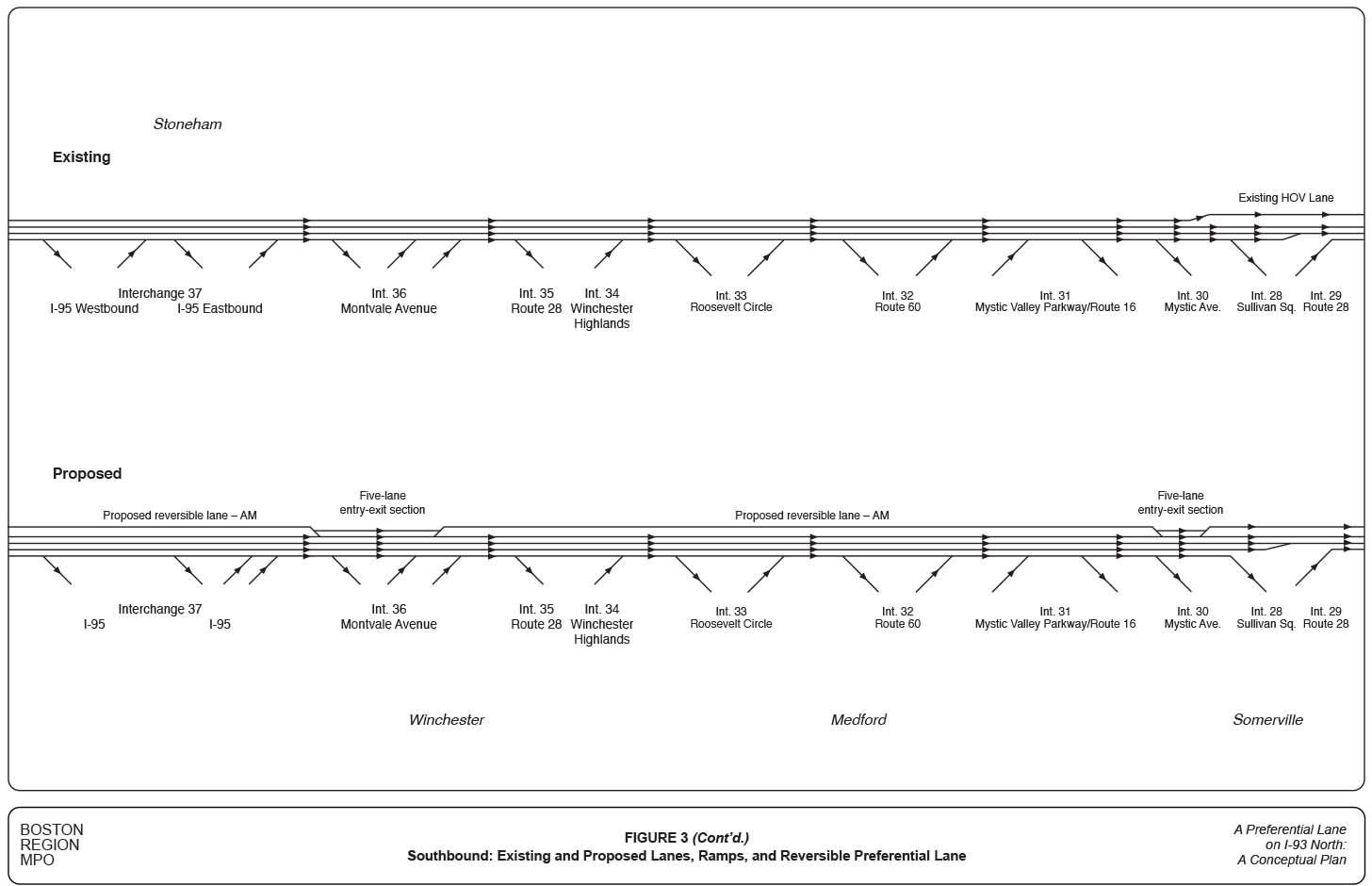
FIGURE 4
Northbound: Existing and Proposed Lanes, Ramps, and
Reversible Preferential Lane
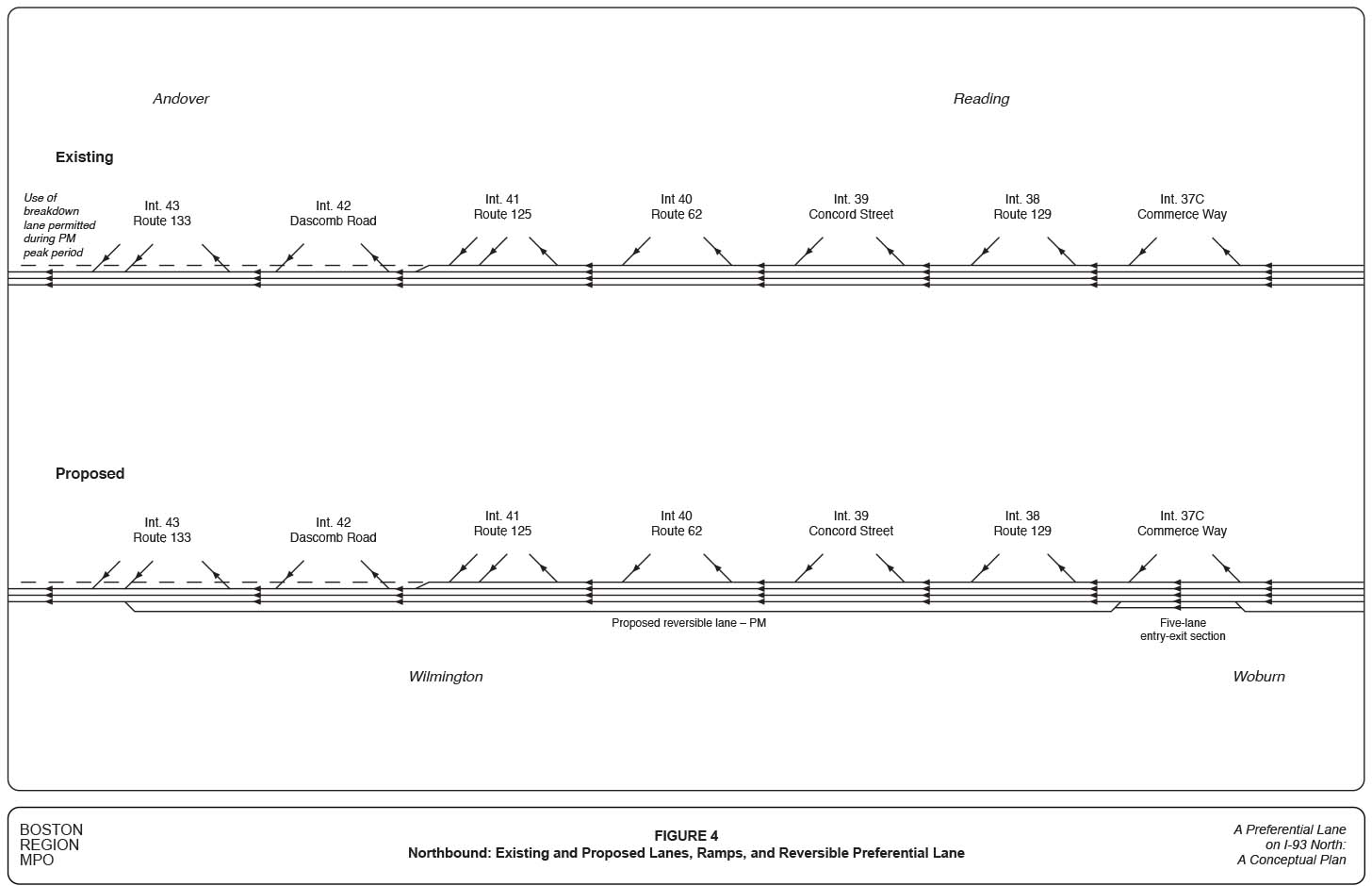
FIGURE 4 (continued)
Northbound: Existing and Proposed Lanes, Ramps, and
Reversible Preferential Lane
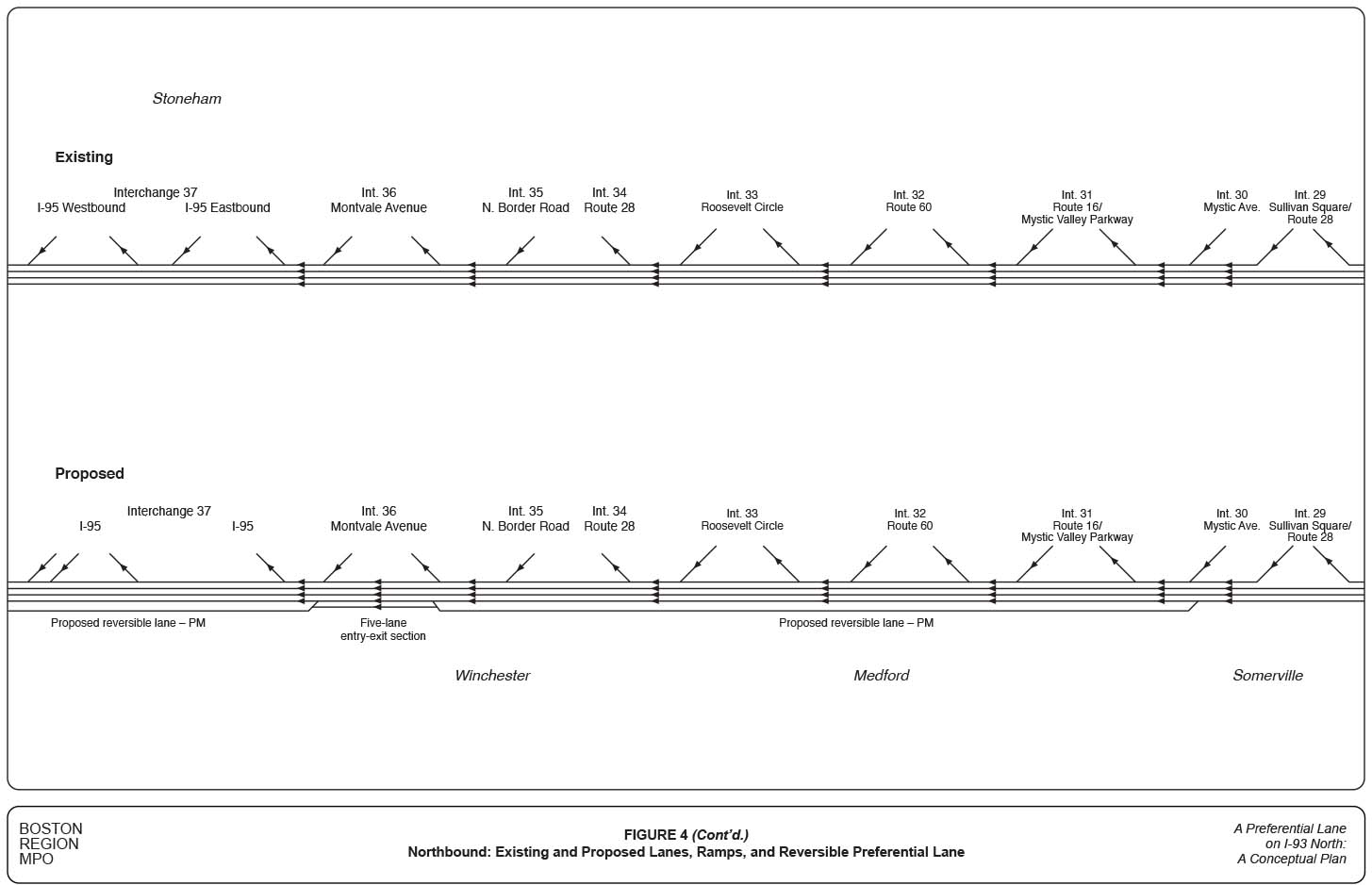
FIGURE 5
2010 Peak-Hour Volumes
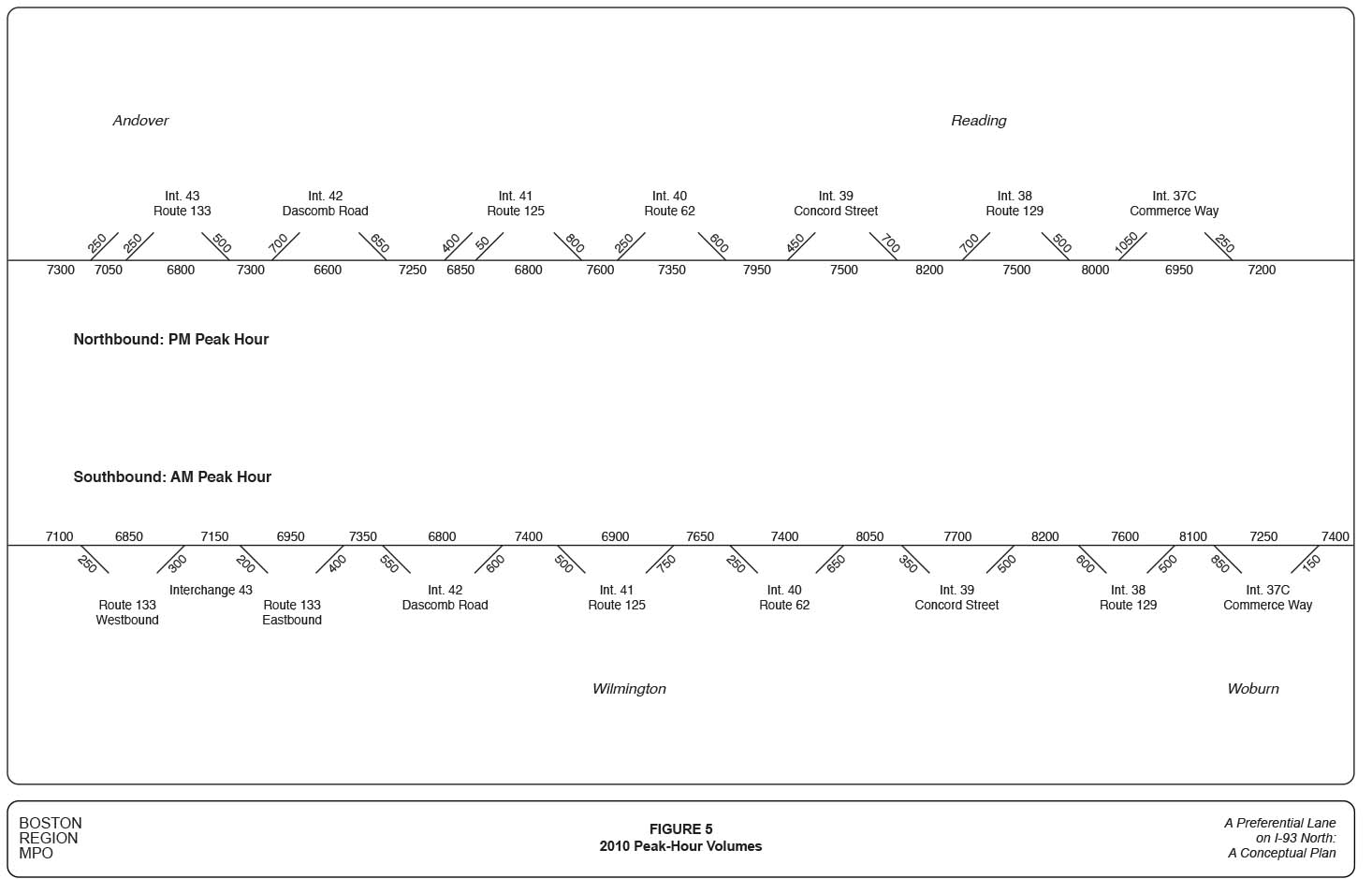
FIGURE 5 (continued)
2010 Peak-Hour Volumes
[back of Figure 5 (continued)]
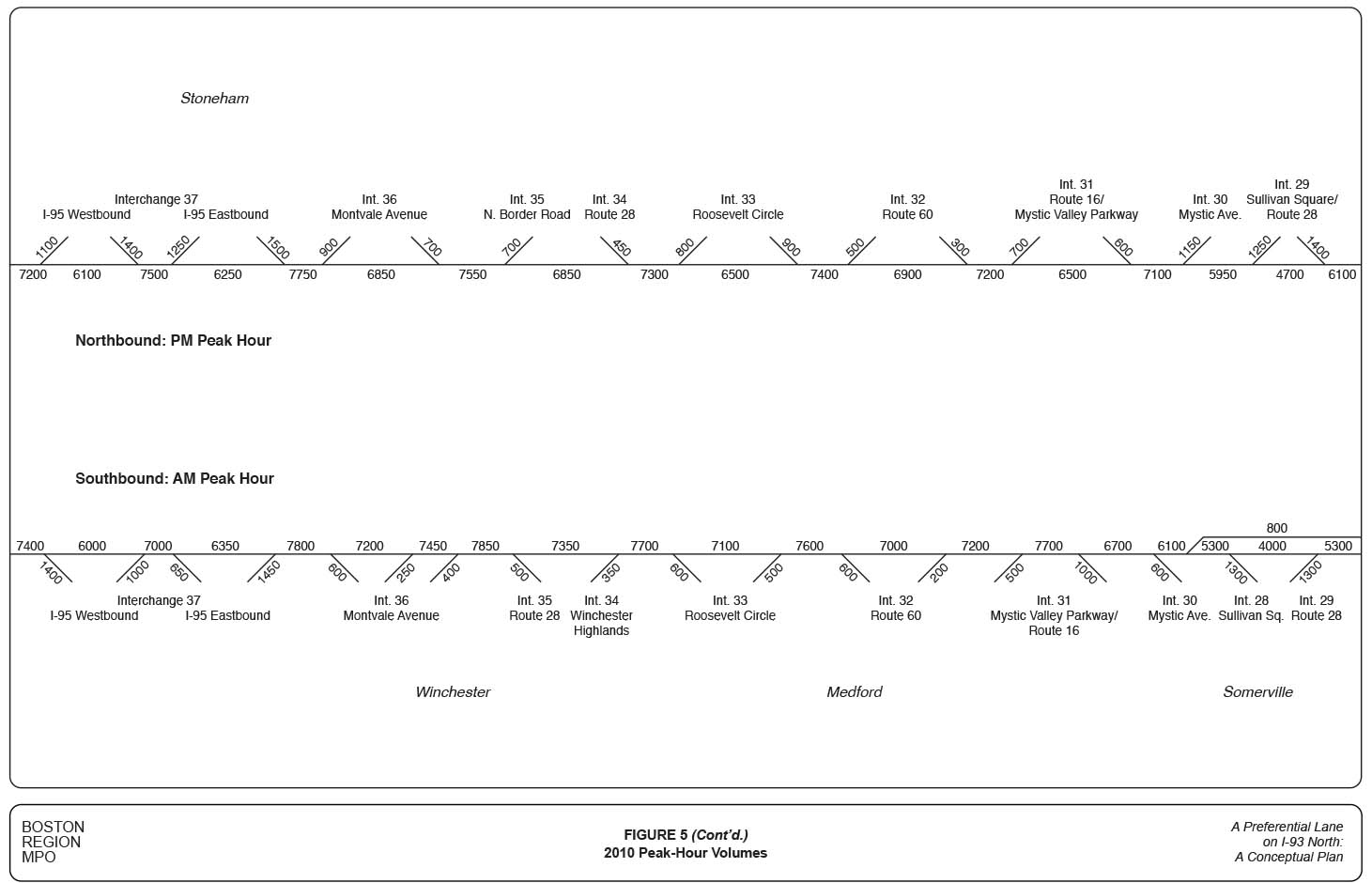
Interchange 37C, Commerce Way, a distance of almost nine miles. On entering the preferential lane, signs would inform users that the next available exit from I-93 will be at Interchange 37/I-95/Route 128.
Currently, during the AM peak hour about 450 southbound vehicles exit at Interchange 43; but 400 vehicles enter, all of which must use the general-purpose lanes. At Interchange 42, Dascomb Road, about 550 vehicles exit and 600 vehicles enter during the peak hour. A full fourth lane begins about three miles south of Interchange 43, shortly before Interchange 41 at Route 125. At Interchange 41, about 500 vehicles exit and 750 enter.
Shortly before Interchange 37C, the reversible lane ends and a five-lane entry-exit section begins, avoiding a forced merge. The entry-exit section is positioned to allow preferential lane users sufficient weaving distance to exit to I-95/Route 128 in either the southbound or northbound direction. These AM preferential lane users will not be able to exit at Interchange 37C, which will only accept traffic from the general-purpose lanes.9
Southbound traffic that has entered I-93 at interchanges 43 through 38 will have an opportunity to enter the central section of the preferential lane system at this entry-exit section. The entry-exit section would be at least 1,000 feet in length, or longer, if projected entering and exiting volumes are sufficiently high. Ideally, preferential lane eligibility would result in 1,500 vehicles per hour using the lane. If dynamic open road tolling were to be implemented, there could be a toll for the northern section and a different toll for the central section. These tolls could be adjusted over the course of the peak period to keep lane use and service level in the desired range.
The central section would be about 2.5 miles in length. It would bypass the ramps that connect with Interchange 37 at I-95/Route 128, and would end at Interchange 36, Montvale Avenue. This study assumes that Interchange 37 would be reconstructed before the preferential lane is built; and the proposed configuration in Figure 3 shows the repositioned ramps in a reconstructed Interchange 37.10
As in the case of Interchange 37C, traffic using Interchange 36 would only be able to use the general-purpose lanes. The entry-exit sections would be located at these interchanges solely to allow safe weaving for preferential lane traffic connecting with I-95/Route 128. Traffic using Interchange 37C would be able to use the southern section of the preferential lane system, but would bypass the central section using the general-purpose lanes. Conversely, traffic using Interchange 36 could use the northern reversible lane section but would use the general-purpose lanes to as far as Interchange 37C.11
Preferential lane vehicles enter the southern reversible lane section at the Interchange 36 entry-exit section. The southern section roughly approximates the portion of I-93 that where a moveable barrier system was considered in the 1994 Feasibility Study. At some point before Interchange 33 at Roosevelt Circle, current AM peak-period traffic accumulates at the back of a slow-moving queue at least 2.5 miles before the beginning of the existing HOV lane.
The proposed preferential lane would bypass this queue and rejoin general-purpose lanes at a five-lane entry-exit section south of the Interchange 30 viaduct at Mystic Avenue about 1,500 feet before the entrance to the existing HOV lane. If the existing HOV lane has use eligibility rules in the future similar to those in the proposed preferential lane, preferential lane users would have the option of continuing on the existing HOV lane to until it becomes a general-purpose lane at the Zakim Bridge.12
The connection of the proposed southern reversible lane section to the existing HOV lane poses a problem for traffic in the general-purpose lanes at that point. The problem can be illustrated by comparing the 2010 AM peak-hour volumes shown in the lower right corner of Figure 5 with the available southbound lanes shown in Figure 3. Presently, after 600 vehicles exit at Interchange 30/Mystic Avenue, the remaining 6,100 vehicles are divided over four lanes. The left-most lane becomes the HOV lane, which is used by about 800 vehicles, leaving 5,300 vehicles to use the three remaining general-purpose lanes. After 1,300 vehicles exit at Interchange 28 to Sullivan Square, the remaining traffic is squeezed into two lanes, which allows the large number of vehicles entering at Interchange 29/Route 28 to enter their own lane rather than merging.
With the inclusion of the proposed reversible lane in this corridor, an additional 1,500 vehicles are expected to join the southbound barrel south of Interchange 30. Using the 6,100 vehicles observed in 2010 as an estimate of peak-hour throughput in the future, this would result in 7,600 southbound vehicles at this point during the AM peak hour. If future eligibility criteria result in 1,500 vehicles using the existing HOV facility rather than the 800 vehicles using it today, there would still be 6,100 vehicles in the remaining general-purpose lanes rather than 5,300 vehicles presently. This increase would exacerbate already severe queuing in the general-purpose lanes, an outcome that proposed improvements should avoid.
Figure 3 shows a proposed solution to the problem of the new reversible lane creating a bottleneck. A fourth lane would be added starting at about where the existing HOV lane begins, but would become an exit-only lane at Interchange 28/Sullivan Square. This proposed enhancement would not help preferential lane users, but it would prevent the preferential lane from slowing traffic in the general-purpose lanes, one of the constraints established in the Phase I Study. Actually, general-purpose traffic should benefit significantly from the addition of this lane, as discussed in the chapter on travel demand modeling.
Figure 4 illustrates schematically how the preferential lane system would function during the PM peak period. Northbound traffic is shown as entering the system at the far right. The heavily traveled ramps at Interchange 29 connect with the frontage road that bounds the Assembly Square development in Somerville.
A northbound HOV lane in this part of I-93 that would complement the southbound HOV lane has been considered, but traffic volumes and available capacity at this location would result in no HOV lane user benefits. As northbound traffic is enters I-93 during the PM peak, especially at Interchange 30 at Mystic Avenue and Interchange 32 at Route 60, the benefits of a preferential lane become apparent.
Northbound traffic enters the reversible lane immediately before the Mystic Avenue viaduct at Interchange 30. The conceptual plan envisions an operations area about 1,000 feet long and between 32 and 44 feet wide. MassDOT personnel would set up traffic cones for the AM peak period to guide southbound traffic from the reversible lane to the existing HOV lane, and confine northbound traffic to the four general-purpose lanes. During the afternoon the reversible lane would be closed to southbound traffic and the traffic cones would be repositioned to allow eligible northbound vehicles to enter the reversible lane.
These operations would be a simpler version of the types of operations that guide eligible vehicles using the Southeast Expressway moveable barrier HOV lane at its two ends at Savin Hill and the Braintree Split. The Mystic Avenue operations area would be unique in one regard. In the southbound direction the preferential lane would enter an entry-exit section since some vehicles from the general-purpose lanes would want to enter the existing HOV lane, in effect creating a fourth section of the preferential lane system in the AM southbound direction. During the PM peak period, Mystic Avenue is the beginning of a three-section northbound preferential lane system and only a northbound entrance is set up.
The 5.5-mile southern section ends at a five-lane northbound entry-exit section near Interchange 36, Montvale Avenue. This northbound entry-exit section is directly adjacent to its five-lane southbound counterpart, and this section of I-93 would have ten lanes altogether with a solid median for a distance of at least 1000 feet. At the ends of the solid median, traffic cones would be set up before peak periods to guide eligible vehicles traveling in the peak direction from the reversible lane and the centermost lane and from the centermost lane to the subsequent reversible lane section.
Northbound preferential lane traffic would be able to change to the general-purpose lanes at the Interchange 36 entry-exit section, and would have sufficient weaving distance to be able to exit to I-95/Route 128 at Interchange 37. Conversely, northbound traffic entering at interchanges 30 at Mystic Avenue through 35 at North Border Road would be able to enter the preferential lane system at this point and use the central and northern sections of the envisioned system.
Eligible vehicles using the central reversible lane section would bypass the Interchange 37 ramps at I-95/Route 128 and have an opportunity to rejoin the general-purpose lanes at the Interchange 37C entry-exit section at Commerce Way. The entry-exit section at Interchange 37C would be configured in the same manner as the Interchange 36 facility at Montvale Avenue. There would be ten lanes with a solid median at least 1000 feet long, and traffic cones would guide eligible vehicles to and from the reversible lane sections at the north and south ends. Traffic connecting from I-95/Route 128 would be able to weave safely from the Interchange 37 ramps and use the northern section of the preferential lane system.
During the PM peak period, users of the northern reversible lane section would bypass interchanges 38 at Route 129 through 43 at Route 133. The northern section ends at Interchange 43, and traffic cones at the northern end of the reversible lane would guide preferential lane traffic to a forced merge with the general-purpose lanes. It is assumed that four general-purpose lanes would be available to accommodate the merging traffic at this point because of the use of the breakdown lane during peak periods, as is the practice today. Preferential lane users exiting the system at the northern end would be able to weave safely to the I-495 ramps at Interchange 44.
Adding capacity in a congested corridor would improve traffic flow, an outcome both intuitively anticipated and reliably reflected by the regional travel demand model. In this study, however, the model is asked to add several important analytical insights about the following:
The regional travel demand model estimates traffic assignments for four discrete periods: the AM peak period, midday, the PM peak period, and night. Four preferential lane design concepts were tested using the AM and PM peak period assignments only. These are three-hour periods, between 6:00 and 9:00 AM in the morning and 3:00 and 6:00 PM in the afternoon. Model results include estimated traffic volumes and average travel times and speeds during the respective three-hour periods.
The regional travel demand model set also assigns several classes of vehicles separately. Personal vehicles with one occupant, or single-occupant vehicles (SOVs), are assigned from their own trip table, and are not permitted in the model assignment to use either the existing HOV lane or the proposed preferential lanes. HOVs are assigned from a separate trip table, but at this point, the model does not distinguish between HOVs with two occupants and HOVs with more than two occupants. Also, the model calibration necessary to test toll strategies on I-93 was outside the scope of this effort.
This study assumes that an optimal set of user benefits would result from 1,500 vehicles per hour using the preferential lane during peak periods. The study also assumes that in 2035, MassDOT would have the ability to set eligibility rules—possibly a combination of occupancy and variable tolls—that would result in preferential lane use of about this level. Assigning the current 2035 HOV trip table has resulted in projected preferential lane volumes of within one or two hundred vehicles of the desired 1,500 vehicles per hour. Based on these results, we assume that traffic assigned to the preferential lane system from the 2035 HOV trip table is a reasonable proxy for usage that would result from future eligibility criteria targeting the 1,500-vehicles usage level.
Recent traffic counts have observed about 800 HOVs using the existing HOV lane during the AM peak hour, and a similar number of HOVs in the general-purpose lanes between interchanges 33 and 34 in Stoneham during the AM and PM peaks hours. The near doubling of HOVs in 2035 predicted by the travel demand model largely reflects that existing HOVs change their travel paths to routes that take advantage of the new preferential lane system. The travel forecasts also incorporate trends in gasoline prices, traffic growth, and land use patterns that can influence carpool formation.
Using the regional travel demand model set, MPO staff estimated the reduced travel times and improved speeds that implementing the proposed preferential lane system could realize. In addition to the no-build alternative, staff tested three distinct improvement concepts for the current long-range planning horizon, the year 2035.
The results of the AM assignments are summarized in Table 1. Model results are presented for 18.3 miles of I-93 in which the preferential lane would be implemented. These 18.3 miles are divided into four parts, the three reversible lane sections plus the part of I-93 at the southern end of the system where a fourth lane is considered as part of the enhanced alternative. The section that includes the proposed fourth lane is only 0.8 miles long, and is labeled in Table 1 as “Embankment,” its most prominent physical attribute.
In the no-build alternative, the 2035 average AM end-to-end trip time for this 18.3 mile system is projected to be 33.3 minutes for general-purpose traffic, and 0.4 minutes faster for users of the HOV lane. Preferential lane and project benefits are calculated only on the embankment where the additional general-purpose lane is being evaluated. After traffic exits for Sullivan Square at Interchange 28, the current HOV lane continues for another two miles until joining general-purpose traffic at the Zakim Bridge. Because no improvements are envisioned in this two-mile stretch, travel times for this section of highway are not calculated.
The travel times at the top of Table 1 are the basis for calculating average speeds shown in the lower part of Table 1. In the case of the no-build alternative, in 2035 all southbound traffic would be confined to the existing general-purpose lanes through most of the distance. The average peak-period speed would be 36 miles per hour (mph) in the north section, drop to 33 mph in the central section, and drop further to 29 mph in the south section.
The current HOV lane begins about 0.3 miles into the embankment section, and averages 44 mph for the entire 0.8 miles. The average speed in the HOV lane itself would be faster, and this pace continues until the Zakim Bridge. The general-purpose lanes speed up a little to 32 mph as traffic exits at Interchange 30, Mystic Avenue. Shortly after the embankment, however, traffic
Table 1
AM Peak Period-Southbound
Projected 2035 Travel Times and Average Speeds
Route 133 in Andover to Sullivan Square Exit in Somerville
| Average Travel | No-Build | Central | Full-Build | Enhanced | ||||||||
|---|---|---|---|---|---|---|---|---|---|---|---|---|
| Times (minutes) | GP | HOV | GP | HOV | GP | HOV | GP | HOV | ||||
| North Section (8.9 miles) | 14.7 | 15.0 | 13.0 | 9.2 | 12.8 | 9.2 | ||||||
| Central Section (3.1 miles) | 5.6 | 4.9 | 3.5 | 5.4 | 3.6 | 5.4 | 3.6 | |||||
| South Section (5.5 miles) | 11.5 | 11.7 | 10.0 | 6.8 | 10.0 | 6.8 | ||||||
| Embankment (0.8 mi.) | 1.5 | 1.1 | 1.5 | 1.1 | 1.8 | 1.3 | 1.1 | 1.2 | ||||
| End-to-End (18.3 miles) | 33.3 | 32.9 | 33.1 | 31.3 | 30.2 | 20.9 | 29.3 | 20.8 | ||||
| Improvement from No-Build | 0.2 | 1.6 | 3.1 | 12.0 | 4.0 | 12.1 | ||||||
| Preferential Lane Advantage | 0.4 | 1.8 | 9.3 | 8.5 | ||||||||
| Average Travel | No-Build | Central | Full-Build | Enhanced | ||||||||
| Speeds (mph) | GP | HOV | GP | HOV | GP | HOV | GP | HOV | ||||
| North Section | 36 | 36 | 41 | 58 | 42 | 58 | ||||||
| Central Section | 33 | 38 | 53 | 34 | 52 | 34 | 52 | |||||
| South Section | 29 | 28 | 33 | 49 | 33 | 49 | ||||||
| Embankment | 32 | 44 | 32 | 44 | 27 | 37 | 44 | 40 | ||||
| End-to-End | 33 | 33 | 33 | 35 | 36 | 53 | 37 | 53 |
Notes: |
||||||||||
|---|---|---|---|---|---|---|---|---|---|---|
| Modeled 2012 end-to-end general-purpose travel times: | 29 minutes (38 mph) | |||||||||
| Average 2006 travel times from observation runs: | 27 minutes (41 mph) | |||||||||
| Central Section calculations include travel in the adjacent entry-exit sections. | ||||||||||
| The Enhanced concept also improves traffic flow north of the preferential lane system. | ||||||||||
| AM travel times between the start of breakdown lane use in Methuen and the entrance to | ||||||||||
| preferential lane system are reduced from 8.8 minutes to 8.3 minutes over the 5.6 miles, | ||||||||||
| an increase in average speed from 38 to 40 mph. | ||||||||||
enters at Interchange 29 from Route 28/the Fellsway, and this merge slows the general-purpose lanes back down.
The smallest improvement being considered is construction of just the central section of the envisioned three-part preferential lane system. Travel time on the 3.1 miles of the central section that includes the two five-lane entry-exit sections would decrease from 5.6 minutes to 4.9 minutes for general-purpose traffic, and would drop to 3.5 minutes for eligible vehicles using the newly constructed central section. This improvement in the central section would attract traffic to the I-93 corridor, and travel times in the unimproved north and south sections would lengthen slightly.
The end-to-end travel times combine all these disparate modeled impacts. The general-purpose lanes would realize a 0.2-minute travel-time reduction from this small improvement, while eligible users of the new central preferential lane section would gain a 1.6-minute travel-time reduction, as shown in the middle of Table 1. The end-to-end advantage to eligible users of the expanded preferential lane system would increase from 0.4 minutes to 1.8 minutes, also shown in Table 1.
The improvements in travel times are reflected in the average speeds. MPO staff predicts that, over the relatively short three-mile central section, general-purpose traffic would speed up from 33 to 38 mph, and travel in the preferential lanes would average 53 mph. Since I-93 would now attract more traffic, average speed on the unimproved south section would slow from 29 to 28 mph. End to end, HOVs would now have a two-mph speed advantage.
The full-build concept includes all three reversible lane sections, but leaves the embankment unimproved. The general-purpose lanes show reduced travel times along each improved section, but lose 0.3 minutes on the embankment because the reversible lane improvements have attracted more traffic to I-93.
End to end, implementing the full-build concept is projected to reduce travel times in the general-purpose lanes by 3.1 minutes. Eligible vehicles using the new preferential lane system would experience a trip taking 12 fewer minutes than in the no-build condition, and 9.3 fewer minutes than in the general-purpose lanes.
Translated into speeds, there is a general pattern of the highest speeds being farthest from Boston, then diminishing as traffic, both general purpose and HOVs, approaches the urban core. General-purpose traffic that had benefited as it traveled through the three improved sections slows down markedly when it reaches the unimproved embankment, as do the HOVs that must use general-purpose lanes for a part of this distance.
End to end, the average speeds of the general-purpose lanes has increased from 33 to 36 mph, and for eligible preferential lane users, the average speed has increased from 33 to 53 mph. If preferential lane eligibility in 2035 is still determined by occupancy, an advantage of this magnitude could be expected to result in some mode shift to HOVs. Alternatively, this travel time advantage would entice some level of toll payment. However, neither mode shift nor toll sensitivity estimates are being developed in the Phase II Study.
The enhanced concept includes the benefits of two additional improvements to I-93 that could complement the proposed preferential lane system. Individually, upgrading the breakdown lanes in Andover and Methuen to full-service fourth lanes and adding a fourth lane on the embankment parallel to the existing HOV lane as far as the Sullivan Square exit would be major projects. However, they might be considered for implementation in conjunction with the extensive reconstruction that building the three reversible lane sections would entail.
The most useful comparison for the enhanced concept is with the full-build concept. Upgrading the managed lanes to full-service fourth lanes improves only the general-purpose lanes in the northern-most three miles of the north section. We predict this would take 0.2 minutes off the general-purpose travel time in this section, reducing it to 12.8 minutes and increasing average speed to 42 from 41 mph in the full-build concept.
The upgrade of the managed lane was modeled to the northern-most extent of its use, 5.6 miles north of the study area. North of the proposed preferential lane system, this improvement reduced travel times by 0.5 minute, increasing the average speed from 38 to 40 mph.
Adding a fourth general-purpose lane to the embankment would reduce the travel time in this short section by 0.7 minutes, increasing average speed to 44 mph from 27 mph in the full-build concept. The traffic flow benefit of adding this lane may be greater than indicated by this model assignment. Queue formation during the AM peak period is a serious problem in this area, which is not fully reflected in the regional model assignment results. At some point, micro-simulation techniques might be used to better estimate the benefits of this auxiliary lane.
End to end, the enhanced concept brings the general-purpose travel time down to 29.3 minutes, which is basically what the regional travel demand model estimates for 2012, as indicated in the notes. The three reversible lanes and complementary improvements are predicted to accommodate 23 years of regional traffic growth without performance degradation. In addition, eligible users of the envisioned preferential lane system could realize an 8.5-minute travel time benefit, a clear incentive to meet whatever eligibility criteria are available to future users.
The results of the PM assignments are summarized in Table 2. Model results are presented for the 17.5 miles of I-93 in which the preferential lane system would be implemented. These 17.5 miles are divided into three parts, each comprising one of the three reversible lane sections. No northbound improvements are considered south of the southern-most reversible section, and traffic on the embankment does not enter into any PM travel time calculations.
In the no-build alternative, the 2035 average PM end-to-end trip time for the 17.5 miles is projected to be 29.9 minutes for all traffic because there is no HOV facility serving this part of I-93. From the travel times per section it is possible to calculate the average speed for each section. Northbound traffic is projected to average 31 mph in the south section, and increase speed in the central and north sections as it moves farther from the urban core, with an average end-to-end speed of 35 mph.
This concept includes just the construction of the central section of the envisioned three-part preferential lane system. Travel time on the 3.1 miles of the central section that includes the two five-lane entry-exit sections would decrease from 5.3 minutes to 4.5 minutes for general-purpose traffic; and would drop to 3.2 minutes for eligible vehicles using the new reversible lane. This improvement in the central section would attract traffic to the I-93 corridor, and travel times in the unimproved north and south sections would lengthen slightly.
The end-to-end travel times in the general-purpose lanes would decrease by 0.4 minute, while eligible users of the new central preferential lane section would realize a 1.7-minute travel-time reduction, as shown in the middle of Table 2. With this small improvement, the end-to-end advantage of the preferential lane would be 1.3 minutes, also shown in Table 2. Traffic speeds would drop slightly in the south section from 31 to 30 mph as more traffic is attracted to I-93, but end-to-end average speed would rise from 35 to 36 mph for general-purpose traffic, and to 37 mph for preferential lane users.
Table 2
PM Peak Period-Northbound
Projected 2035 Travel Times and Average Speeds
Mystic Avenue Viaduct in Somerville to Route 133 in Andover
| Average Travel | No-Build | Central | Full-Build | Enhanced | ||||||||
|---|---|---|---|---|---|---|---|---|---|---|---|---|
| Times (minutes) | GP | GP | HOV | GP | HOV | GP | HOV | |||||
| South Section (5.5 miles) | 10.7 | 11.0 | 9.3 | 6.6 | 9.4 | 6.6 | ||||||
| Central Section (3.1 miles) | 5.3 | 4.5 | 3.2 | 4.9 | 3.8 | 5.0 | 3.8 | |||||
| North Section (8.9 miles) | 13.9 | 14.0 | 11.8 | 9.4 | 11.5 | 9.5 | ||||||
| End-to-End (17.5 miles) | 29.9 | 29.5 | 28.2 | 26.0 | 19.8 | 25.9 | 19.9 | |||||
| Improvement from No-Build | 0.4 | 1.7 | 3.9 | 10.1 | 4.0 | 10.0 | ||||||
| Preferential Lane Advantage | 1.3 | 6.2 | 6.0 | |||||||||
| Average Travel | No-Build | Central | Full-Build | Enhanced | ||||||||
| Speeds (mph) | GP | GP | HOV | GP | HOV | GP | HOV | |||||
| South Section | 31 | 30 | 35 | 50 | 35 | 50 | ||||||
| Central Section | 35 | 41 | 58 | 38 | 49 | 37 | 49 | |||||
| North Section | 38 | 38 | 45 | 57 | 46 | 56 | ||||||
| End-to-End | 35 | 36 | 37 | 40 | 53 | 41 | 53 |
| Notes: | |||||||||||
|---|---|---|---|---|---|---|---|---|---|---|---|
| Modeled 2012 end-to-end general-purpose travel times: | 26 minutes (41 mph) | ||||||||||
| Average 2006 travel times from observation runs: | 21 minutes (50 mph) | ||||||||||
| Central Section calculations include travel in the adjacent entry-exit sections. | |||||||||||
| The Enhanced concept also improves traffic flow north of the preferential lane system. | |||||||||||
| PM travel times between the northern end of the preferential lane system and the end of | |||||||||||
| breakdown lane use in Methuen are reduced from 5.9 minutes fot 5.6 minutes over the | |||||||||||
| 5.6 miles, an increase in average speed from 57 to 60 mph. | |||||||||||
The full-build concept includes all three reversible lane sections, and the general-purpose lanes show reduced travel times in each section when compared with the no-build alternative. End to end, implementing the full-build alternative is projected to reduce travel times in the general-purpose lanes by 3.9 minutes. Eligible vehicles using the new preferential lane system would experience a trip taking 10.1 fewer minutes than in the no-build condition, and 6.2 fewer minutes than in the general-purpose lanes.
Calculating the average speed for each section, northbound traffic is projected to average 35 mph in the south section, and increase speed in the central and north sections as it moves farther from the urban core with the average end-to-end speed being 40 mph. Preferential lane users would traverse the south section at 50 mph, the central section (which includes the entry-exit sections) at 49 mph, and the north section at 57 mph, with an end-to-end average of 53 mph.
End to end, the average PM speeds of the general-purpose lanes are projected to rise from 35 to 40 mph, an increase of 5 mph; and for preferential lane users the average speed would grow from 35 to 53 mph, an increase of 18 mph. These projected PM speed increases contrast with the AM increases of 3 mph for general-purpose traffic and 20 mph for preferential lane users.
These patterns of benefits meet the Phase I planning criteria. Preferential lane implementations should improve general-purpose traffic flow, but would improve traffic in the preferential lane even more. However, the model predicts a greater benefit differential during the AM peak period than during the PM peak period, which could have implications with respect to mode shift or toll sensitivity.
In the enhanced concept, the only improvement relevant to PM peak travel is upgrading the breakdown lanes in Andover and Methuen to full-service fourth lanes. Compared with the full-build concept, the enhanced concept would reduce general-purpose travel times in the north section from 11.8 to 11.5 minutes, and end-to-end travel times from 26 to 25.9 minutes, increasing the end-to-end speed from 40 to 41 mph. North of the north section, the full upgrade of the managed lanes would reduce travel times from 5.9 to 5.6 minutes, and increase PM peak-period speeds from 57 to 60 mph.
Both the full-build and enhanced concepts bring the end-to-end general-purpose travel time down to about 26 minutes, matching the regional travel demand model estimates for 2012 in the same manner as the improvements proposed for the AM peak period. The three reversible lanes are predicted to accommodate 23 years of PM peak regional traffic growth without performance degradation. In addition, eligible users of the envisioned preferential lane system could realize a 6.0-minute travel-time benefit, providing an incentive to meet the eligibility criteria available to future users.
The 2035 travel time projections presented here are based on official population and employment projections for the Boston MPO travel demand model region. It is useful however, to consider potential sources of increased I‑93 traffic. Even assuming future growth is slower than growth in the past, any increase in vehicular travel between destinations along the I-93 corridor north of Boston will increase congestion.
In addition to gradual population growth as well as somewhat stronger employment growth associated with economic recovery, the widening of I-93 in southern New Hampshire will also attract traffic to this corridor. Traffic growth on I-93 was observed to pause after US 3 was widened in the early 2000s, making US 3 a more attractive route for many regional trips. Traffic growth later resumed on I-93, a trend which should continue as capacity is increased in New Hampshire.
One of the environmental mitigation programs associated with this widening has been state sponsorship of the startup costs of some new regional bus services between southern New Hampshire and Boston. These new routes serve new or improved park-and-ride lots and supplement the already successful regional bus services between Boston and upper New England.13
While the proposed preferential lane system has been analyzed primarily as a congestion relief strategy, it has the potential to serve as a central component of an emerging network of regional bus rapid transit (BRT) services. Regional buses using the entire length of the expanded system during the AM peak period are predicted to have a nine-minute travel-time advantage in 2035 over traffic in the general-purpose lanes. These buses would gain an additional four-minute advantage if they use the existing HOV lane all the way to the Zakim Bridge. Buses entering the system at other locations, as well as buses traveling during the PM peak period would realize smaller, but still significant travel-time advantages.
Privately operated commuter bus services are largely invisible to the public, yet have proved to be a viable business model in a number of commuting markets. If these services can survive and expand in today’s travel markets and express highway congestion, these services would be in an even stronger competitive position in 2035, with expected larger markets and greater congestion. With a complete preferential lane system around which to build their services, a large and viable regional bus system north of Boston could become an important feature of the regional transportation network.
The expanded preferential lane system is built around a set of three 28-foot wide reversible lanes. This standard allows unimpeded traffic flow even around breakdowns or enforcement activity, reinforcing the BRT concept. It would also allow a substantial number of vehicles to use the lane with no service degradation. This study assumes that 1,500 vehicles per hour are permitted by some eligibility rule to use the preferential lane. At this traffic level, it would be as if the buses were using a bus-only lane.
The proposed preferential lane system would increase the total number of peak-period lanes on I‑93 from eight to nine. The regional travel demand model predicts that without any improvements, the end-to-end travel times over the length of the proposed project would lengthen by four minutes in both the AM and PM peak periods. Adding a ninth lane, utilized as described in this study, is predicted to bring 2035 travel times in the general-purpose lanes back to their 2012 levels. As described above, users of this new, ninth lane, would realize a significant travel time advantage, which could justify buying a bus ticket, forming a carpool, or paying a toll.
The addition of four additional minutes to peak-period commutes would be the result of gradual growth in population and economic activity. The travel behavior of individuals may gradually evolve, possibly towards less or towards more driving. Considered altogether, the regional travel demand model predicts more traffic. The envisioned preferential lane system is predicted to accommodate this growth, something that would challenge an unimproved I-93.
Implementation of the enhanced concept is projected to reduce daily carbon dioxide emissions by 12 tons, a reduction of about 0.07 percent across the travel demand model region. A slight increase in vehicle-miles traveled (VMT) is projected as drivers currently using congested arterials would change their routes to take advantage of the improved speeds and reduced congestion on I‑93. This increase in VMT is more than counterbalanced by a reduction in travel times resulting from increased speeds in the new preferential lane, the I‑93 general-purpose lanes, and less-congested regional arterials.
Carbon dioxide emissions are directly proportionate to gasoline consumption and are reduced by any investment that improves fuel economy. The proposed preferential lane reduces these emissions by reducing lengthy idling at congested intersections and repeated acceleration and braking in stop-and-go traffic.
This section discusses several design and construction issues, and implicit in this discussion is the issue of feasibility. In a strict sense, feasibility can be established or ruled out based on whether a design respects one or more binding constraints. The primary approach of this study is to highlight cost and constructability issues and assume that administrative mechanisms and construction techniques exist to realize the general plan around these issues.
There is one feasibility test that has been strictly adhered to throughout this study. The conceptual plan described in Section 3 that is projected to offer the user benefits described in Section 4 must be incorporated into the I-93 corridor in a manner consistent with industry guidelines for safety and operations.
The analysis begins with a discussion of the design of the reversible lane and its advantages over the two-way alternative for this preferential lane implementation. Alternative designs of entry-exit sections and issues surrounding their safe and effective location are then discussed.
The proposed reversible lane, possible entry-exit section designs, and other projects being considered in the I-93 corridor all have implications for the adequacy of the existing right-of-way. The next section begins with a brief description of the existing roadway widths and then discusses some of the issues related to fitting the proposed system into the existing right-of-way or, where necessary, expanding the right-of-way.
The preferential lane system described in this memorandum would require either major modification or complete reconstruction of 15 overpasses that cross I-93. The location and condition of these overpasses are described in the next part of this section. This section concludes with a discussion of construction on the embankment where the proposed preferential lane joins the existing HOV lane.
The reversible lane configuration recommended in this study is shown in cross-section at the bottom of Figure 6. Safety standards dictate that a reversible lane is separated from the general-purpose lanes by concrete barriers, and any
FIGURE 6
Two-way and Reversible Lane
Cross-sections Compared
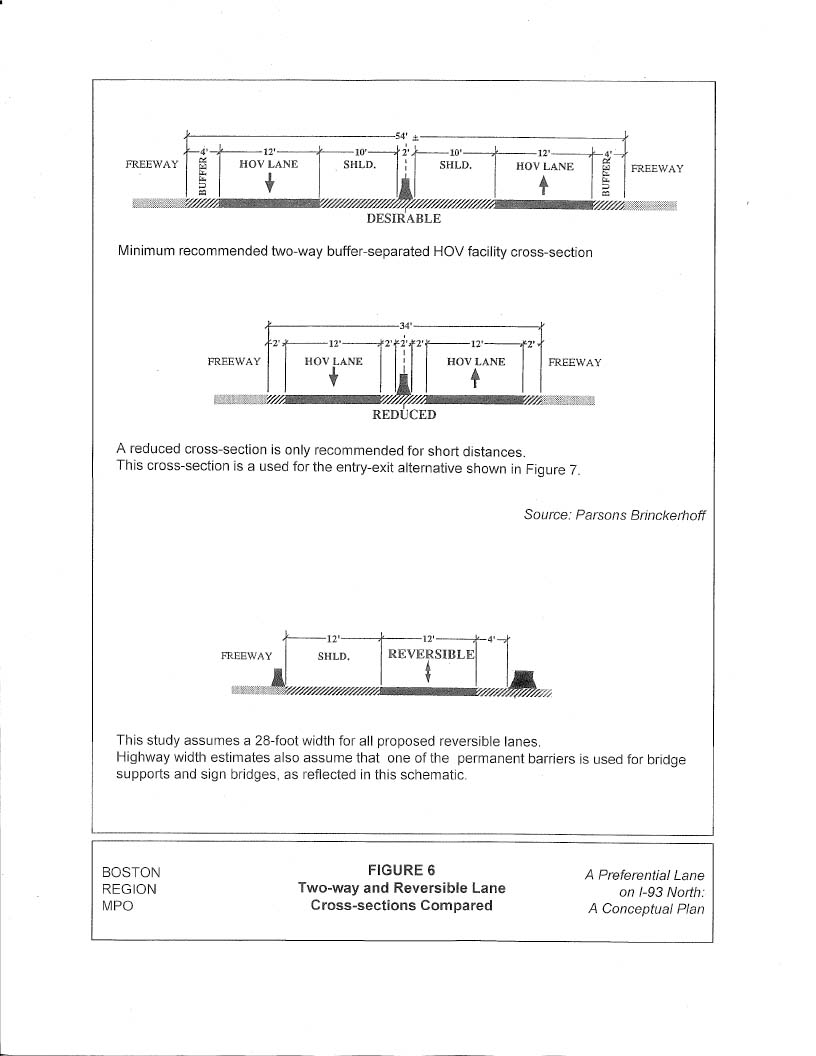
pavement used for breakdowns or enforcement needs to be located within the barriers that protect the reversible lane15.
The recommended reversible lane width is 28 feet. While narrower reversible lanes have been implemented in the US, the recommended 28-foot width is assumed in this study so that the modeled travel-time benefits can be realized even in instances of minor breakdowns or enforcement activity.16
Construction of a reversible lane between the opposing sets of general-purpose lanes poses two challenges. First, assuming no reduction in the number of general-purpose lanes, the amount of paved roadway would need to be increased, usually by widening the highway. Second, bridge supports could no longer be located at the centerline of the highway, since there would be an active lane occupying the middle of the corridor.
If bridge supports were able to remain at their existing location, the extent and cost of required bridge reconstruction might be significantly reduced. Two alternative preferential lane configurations are shown at the top of Figure 6. Both these alternatives add a preferential lane in each direction, maintaining the symmetry of the highway lanes and potentially eliminating or simplifying required bridge improvements. These lanes are separated from the general-purpose lanes by narrow, painted buffers.
The reduced cross-section shown in the middle of Figure 6 is similar in width to the proposed reversible lane. The advantage of this configuration is that some bridges might be able to accommodate the added lane with minimal modification, such as narrowing the breakdown lane for a short distance. Another advantage is that use of the added lane in the off-peak direction could offer benefits during traffic incidents or possibly during future peak periods if growth trends reflect increased reverse commuting.
The reduced configuration is only recommended for short distances, however. The desirable buffer-separated configuration, shown at the top of Figure 6, is 20 feet wider than the reduced configuration, and provides a pair of 10-foot shoulders for the two preferential lanes. Without these shoulders, many incidents in a reduced buffer-separated system would result in lower speeds and delays in the preferential lane, a situation designed to be avoided in the recommended reversible lane.
Entry to and exit from the preferential lane sections would be at-grade. Dedicated ramps that would bring traffic from connecting interchanges directly into the preferential lane are not envisioned. Vehicles using the proposed at-grade entry-exit sections would need to be in the left-most general-purpose lane in order to enter the preferential lane. Design guidelines recommend that the parallel general-purpose and preferential lanes allow a distance of between 1,000 and 1,500 feet in which vehicles can enter or exit the preferential lane system.
The choice of design of the entry-exit section can present entering vehicles two options:
Both of these configurations are considered acceptable, though it is recommended that a weave lane be provided wherever possible. It is possible that a preferential lane system could be constructed with weave lanes included at some entry-exit locations, depending on traffic conditions and the availability of land. It also is assumed that the user benefits estimated earlier would be realized using either configuration.17
The entry-exit section shown schematically at the top of Figure 7 would have a cross-section similar to the reduced two-way HOV lane system shown in the middle of Figure 6. The reduced cross-section is acceptable for short distances, and the use of this configuration between two barrier-separated reversible lane sections would be appropriate.
FIGURE 7
Narrow Corridor
Entry-Exit Section
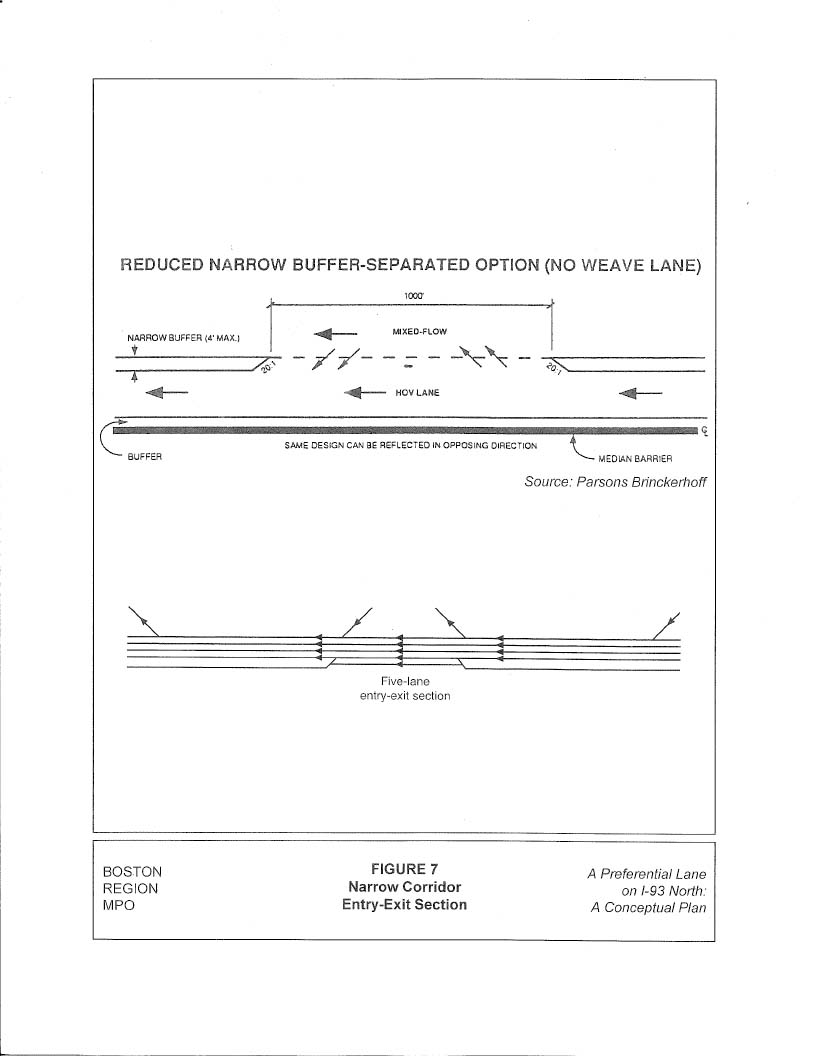
FIGURE 8
Wide Corridor
Entry-Exit Section
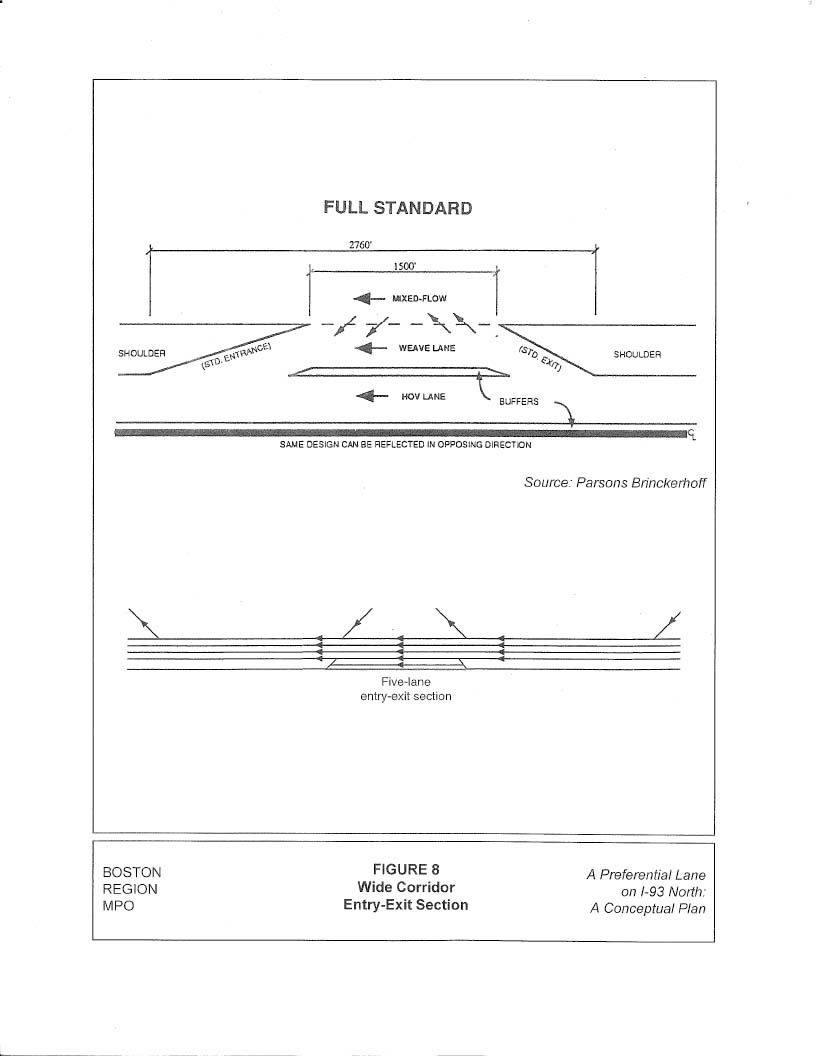
Using this configuration, an entry-exit section could be constructed within the same 160-foot roadway width that is being assumed for the highway sections with the reversible lane. This includes a 10-foot concrete median and two 75-foot barrels, one in each direction. Each 75-foot barrel would have five 12-foot lanes, a 10-foot shoulder, a two-foot buffer between the preferential lane and the general-purpose lanes, and three feet of separation between the preferential lane and the concrete median.
The simplicity and relative economy of implementing the narrow corridor option is offset by the lack of a weave lane. As indicated in Tables 1 and 2, travel in the preferential lanes is expected to be about 18 mph faster than in the general-purpose lanes during the AM peak period (52 versus 34 mph) and about 12 mph faster during the PM peak period (49 versus 37 mph). The suitability of the narrow corridor option may depend upon the number of vehicles trying to enter or exit at each entry-exit section.
Not shown in Figures 7 or 8 are the necessary transition areas between the reversible lane and the entry-exit section. The operations of the transition sections can be illustrated with the diagrams in Figure 6. Between the reversible lane with its two concrete barriers and a two-way entry-exit section with one central concrete barrier would be a gap of about 500 feet that has no concrete barrier. At designated times of day traffic control barrels would be set up to connect the central concrete barrier of the two-way section with one of the two concrete barriers protecting the reversible lane. This action determines whether traffic can use the reversible lane in the northbound or the southbound direction. The reversible lane sections would be closed, cleared, and reversed in an analogous but simpler manner than the moveable barrier operations on the Southeast Expressway.
If it is determined that a weave lane should be included at a particular entry-exit location, the required corridor width would increase by 12 feet to 172 feet if the weave lane were added in one direction, or to 184 feet if weave lanes were added in both directions. The transition areas would operate in the same manner as described above, but would need to be positioned further from the weaving section to allow for standard exit and entrance tapers between the preferential lane and the weave lane.
The wide-corridor option would need to be at its full width for the length of the 1,500-foot weave lane. The taper sections require 360 feet before the weave lane and 900 feet after the weave lane, for a total of 2,760 feet to implement the entry-exit section to this standard. The two 500-foot transition sections would precede and follow the entry-exit section, but the transition sections only require the basic 160-foot widened roadway.
The length of the weaving section and the addition of a dedicated weave lane are two separate issues. The recommended length is between 1,000 and 1,500 feet. If the lane exceeds 1,500 feet, it is possible that general-purpose traffic would use the entry-exit section for passing, a use that should be discouraged. Less than 1,000 feet is considered inadequate for any reasonable volume of lane changing. This study recommends that all weave sections be 1,500 feet in length, regardless of whether or not a dedicated weave lane is incorporated into the design.
The placement of entry-exit sections is critical for ensuring that the projected user benefits can be realized. The at-grade entry-exit sections described above require entering vehicles to be in the left-most general-purpose lane to enter the preferential lane, and vehicles leaving the preferential lane change to this left-most lane, from which point they continue their trip. Since all users of the preferential lane must weave safely to or from the left-most general-purpose lane, the placement of the several entry-exit sections in relation to nearby interchanges would determine which interchanges offer users access to each section of the preferential lane system.
Making the preferential lane system accessible to major vehicle flows requires locating the entry-exit sections to allow safe access. Conversely, safe traffic operations on I-93, for both preferential and general-purpose traffic, may require precluding access to the preferential lane at certain interchanges where weaving distances are inadequate. The unsuitability of use should be so unmistakable that even aggressive drivers would not attempt the required lane changes that separate the preferential lane from a precluded interchange.
The general approach of this study to the problem of entry-exit section placement is illustrated in the lane diagram schematics at the bottom of Figures 7 and 8. In this study, each entry-exit section is assumed to be as close as practicable to a particular interchange. This precludes use of that particular entry-exit section by traffic using the associated interchange. Vehicles entering at one of these associated interchanges can use the preferential lane system provided that they travel in the general-purpose lanes to the next available preferential lane entrance.
While access to the preferential lane system at a particular entry-exit section is precluded to users of the associated interchange, there is ample distance for users of the adjacent interchanges located to the north and south of the entry-exit section to weave to or from the left-most lane when entering or exiting the preferential lane. This relationship between a precluded associated interchange and its usable adjacent interchanges is also reflected in the lane diagrams in Figures 7 and 8. The basic configuration shown schematically in Figure 7 appears several times in the system diagrams in Figures 3 and 4.
Implicit in the discussion of the location of entry-exit sections is the understanding that access to the preferential lane system must be maintained at certain interchanges, but can be sacrificed at the interchanges associated with a particular entry-exit section. Vehicles using these associated interchanges would be able to use the general-purpose lanes and access the preferential lane system at a different entry-exit section.
Review of ramp volumes confirms the expected circumstance that Interchange 37 at I‑95/Route 128 serves the greatest number of vehicles connecting with I‑93. This study recommends that entry-exit sections north of I‑95/Route 128 near Interchange 37C/Commerce Way and south of I-95/Route 128 near Interchange 36/Montvale Avenue be built so as to ensure access to and from Interchange 37/I‑95/Route 128. Vehicles using Interchange 37C/Commerce Way or Interchange 36/Montvale Avenue would have to use the general-purpose lanes but would be able to access a reversible lane section at a different location.
The optimal location of an entry-exit section may not be as close to the associated interchange as suggested in Figures 7 and 8. The desirability of designing around bridge structures, incorporating a weave lane, using available right-of-way, or reducing land takings and other impacts might suggest that the optimal location is somewhat to the north or south of the associated interchange. An optimal location based on constructability and environmental impacts would also need to preclude unsafe access from the associated interchange through signage, pavement treatments, or managing sight lines.
Allowing the necessary weaving to take place over two highway segments instead of one allows much greater flexibility in the placement of the entry-exit sections consistent with safe weaving distances. This design flexibility can be quantified, and summary calculations are presented in Table 3. The locations of interchanges in Table 3 are shown in a set of diagrams drawn to scale in Figures 9 through 11.
The first column in Table 3 lists the interchanges associated with an entry-exit section, or in the bottom of the table, with access to an endpoint of the preferential lane system. The second column lists the interchanges that would be able to use the entry-exit sections or to access the ends of the system.
In the center of Table 3 is a column showing the distance between the two usable interchanges. This distance is from the entrance merge where some users will want to safely enter the preferential lane to the off-ramp where users leaving the preferential lane system may wish to safely exit. Viewed
Table 3
Establishing Safe Weaving Distances between
Entry-Exit Sections and the Nearest Usable Interchanges
All Distances in Feet
| Distance | Average | Entry-Exit | ||||||
|---|---|---|---|---|---|---|---|---|
| Between | Available | Section | ||||||
| Associated | Usable | Usable | Distance per | Position | ||||
| Interchange | Interchanges | Interchanges | Lane Change | Window | ||||
| Southbound Entry-Exit Sections | ||||||||
| 37C | Commerce Way | 38 | Route 129 | 11,775 | 1,475 | 8,900 | ||
| 37 | I-95/Route 128 | |||||||
| 36 | Montvale Avenue | 37 | I-95/Route 128 | 8,600 | 1,122 | 5,750 | ||
| 35 | North Border Road | |||||||
| 30 | Mystic Avenue | 31 | Mystic Valley Pkwy. | 9,000 | 1,312 | 6,800 | ||
| 28 | Sullivan Square | |||||||
| Northbound Entry-Exit Sections | ||||||||
| 36 | Montvale Avenue | 35 | North Border Road | 10,860 | 1,373 | 8,000 | ||
| 37 | I-95/Route 128 | |||||||
| 37C | Commerce Way | 37 | I-95/Route 128 | 11,140 | 1,404 | 8,300 | ||
| 38 | Route 129 | |||||||
| Access at Ends of System | ||||||||
| 43 | Route 133 | 44 | I-495 | 5,700 | 1,900 | NA | ||
| southbound to north section entrance | ||||||||
| 43 | Route 133 | 44 | I-495 | 6,000 | 2,000 | NA | ||
| northbound from north section exit | ||||||||
| 30 | Mystic Avenue | 29 | Route 28 | 4,000 | 1,333 | NA | ||
| northbound to south section entrance | ||||||||
| Notes: | |||||||
|---|---|---|---|---|---|---|---|
| The 1,500-foot entry-exit distance is available for both exiting and entering vehicles. | |||||||
| Available distance per lane change includes weaving across any future auxilliary lanes | |||||||
| being considered for implementation. | |||||||
FIGURE 9
North Section Interchanges
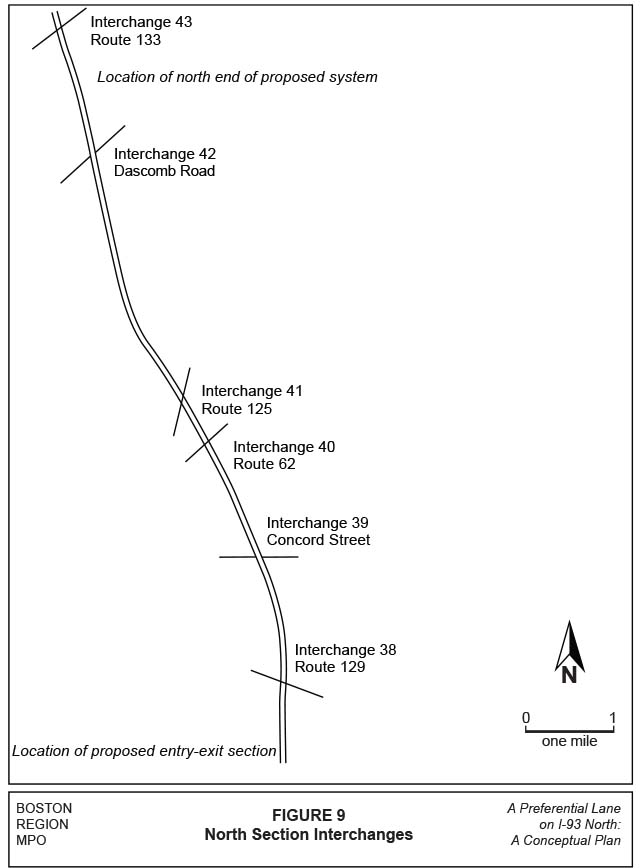
FIGURE 10
Central Section Interchanges
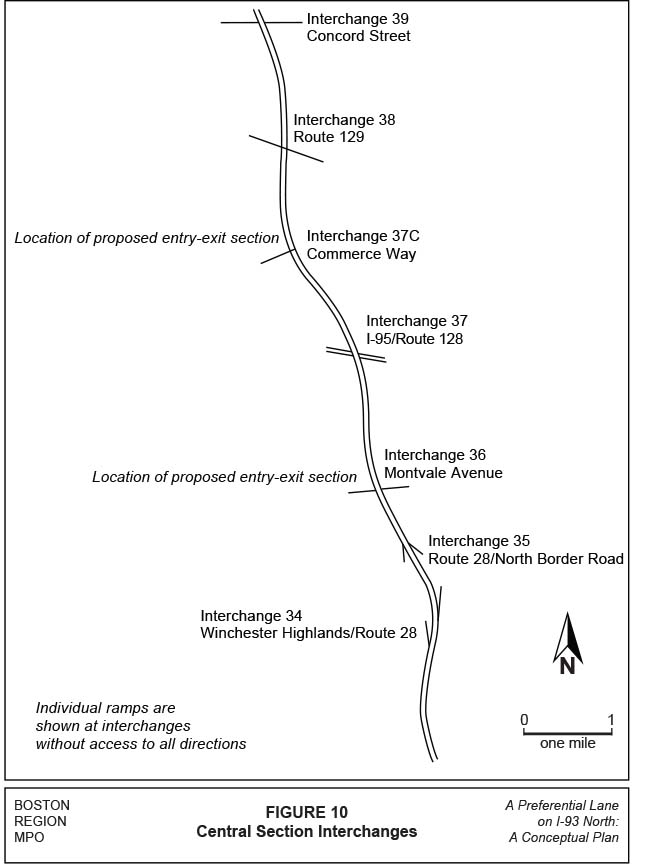
FIGURE 11
South Section Interchanges
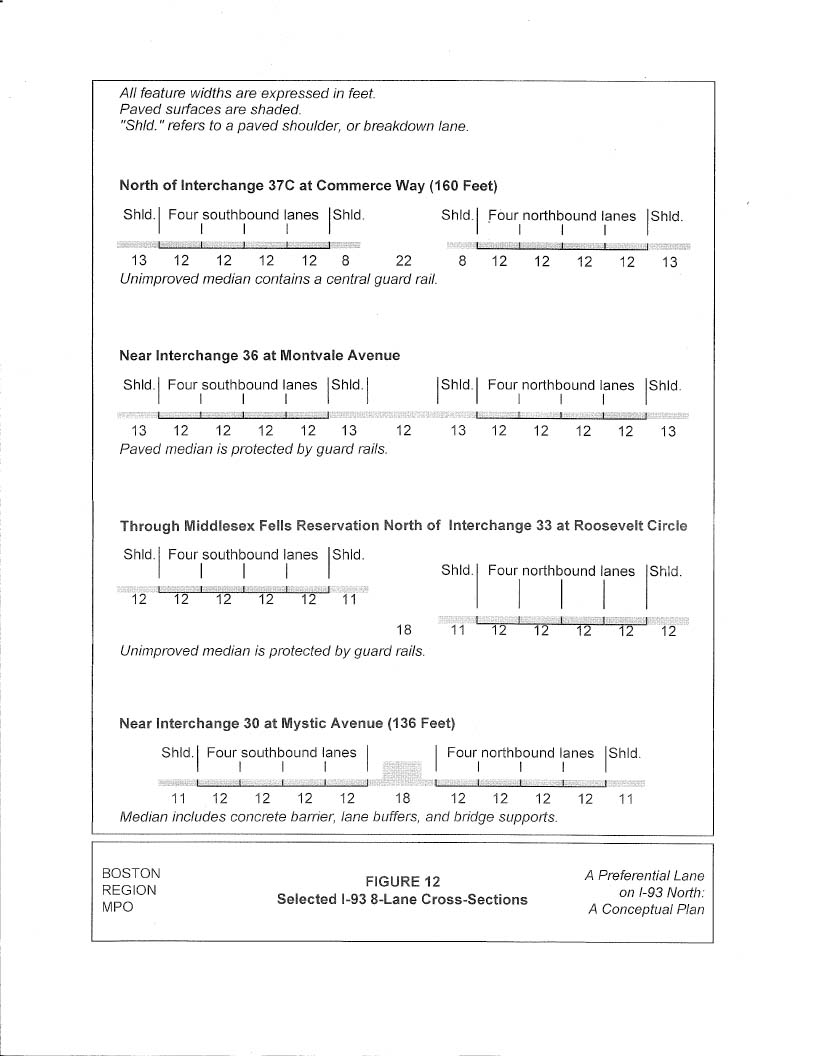
schematically at the bottom of Figure 8, this would be the distance from the entrance merge on the right to the exit at the left of the figure. The distances in the bottom part of Table 3 are between the system endpoints and the nearest usable interchange.
The second column of distances is calculated by dividing the total distance available for weaving between the two usable interchanges by the combined number of lane changes required for the pair of usable interchanges to use the entry-exit section. In the first entry, there are 11,775 feet between the southbound on-ramp at Interchange 38/Route 129 and the off-ramp at Interchange 37/I‑95/Route 128. The distance available between interchanges 37 and 38 can be seen in Figure 10.
Vehicles entering at Interchange 38 will need to weave across four lanes in order to enter the preferential lane. Vehicles leaving the preferential lane destined for I-95/Route 128 will need to weave across five lanes, counting a new auxiliary lane that is being considered as part of the I‑93/I‑95 reconstruction. This makes a combined total of nine lane changes that the distance between the two usable interchanges needs to accommodate.
The vehicles weaving to the preferential lane and the vehicles weaving from the preferential lane both would be able to utilize the entire 1,500 feet of the entry-exit section. Adding another 1,500 feet of distance to account for this section being used by both exiting and entering traffic gives a total of 13,375 feet of roadway available for traffic to change lanes between the usable interchanges and the entry-exit section. Dividing this total by the combined nine lanes gives 1,475 feet per lane change.
Auxiliary lanes are considered for several locations in the planned reconstruction of the I‑93/I‑95 interchange, and the combined lane changes for each of these locations was considered to be nine lanes. The combined lane changes for the Mystic Avenue entry-exit section is considered to be eight lanes, which also reflects improvements proposed in this study. The distances per lane change shown at the bottom of the page are the total distance divided by three, the number of required lane changes at the ends of the system.
There is only one location where each entry-exit section could be built between its usable interchanges that would result in the average distance per lane change being available to both entering and exiting vehicles. If the entry-exit section were built anywhere else, entering and exiting vehicles would have a different distance available per lane change, one group above the average and the other below.
Ideally, 1,000 feet should be available per lane change, but weaving distances as low as 500 feet are acceptable depending on conditions. This analysis uses minimum allowable weaving distance of 650 feet per lane. Given this 650-foot minimum weave distance, there is a limit as to how close an entry-exit section could be constructed to a usable interchange. If construction of an entry-exit section is disallowed too close to a usable interchange, there is still a considerable extent of I-93 within which the 1,500-foot entry-exit section could be constructed with the minimum weaving distance per lane exceeding 650 feet. This “position window” is shown in the right-most column of Table 3.
In this study, MPO staff defined and calculated the position window in order to give a degree of confidence to the user benefits estimated by the regional travel demand model. The estimate of user benefits was predicated on the proposed system’s ability to serve key travel markets and accommodate important vehicle flows. The results predicted by the travel model would not change appreciably by locating an entry-exit section at a different point within the position window. The results could change dramatically, however, if an entry-exit section had to be removed because no location could be identified that reflected modern design standards.
As they have been defined here, the position windows are quite large, ranging from about 1.1 to 1.7 miles. This available distance in no way minimizes the challenge of placing a 1,500-foot, or 0.3 mile entry-exit section and associated transition areas, weave lane, or ramp tapers into a limited right-of-way.
Construction of the three reversible lane sections would require adding a significant amount of pavement surface throughout the corridor. At some locations land acquisition probably would be required. The need to add pavement and acquire land can be attributed to four distinct design considerations:
Even if the preferential lane and related improvements fit entirely within the current right-of-way, higher peak-hour volumes or closer roadway proximity to housing, parks, or wetlands outside the right-of-way could be considered a noise, visual, or other negative impact. While impacts to these physical features in the vicinity of the proposed highway widening can be in instances mitigated, these potential impacts represent the true constraint on reconstructing highway, rather than the right-of-way limit, per se. Some mitigation measures themselves, such as sound barriers, also could require land acquisition.
Figure 12 depicts schematic cross-sections of I-93 at four locations within the preferential lane corridor. In its most constricted configuration, the eight lanes utilize 136 feet of improved roadway as shown in the lower-most cross-section. North of Roosevelt Circle, the roadway widens to a minimum of 160 feet between the outer edges of the breakdown lanes. Three 160-foot cross-sections are shown in Figure 12, differing primarily in their treatment of the median.
The reversible lane cross-section shown in Figure 6 is assumed to be 40 feet wide. This includes the 28-foot road surface, a two-foot wide concrete barrier, and a ten-foot wide barrier that would accommodate bridge supports and sign bridges. The 40-foot reversible lane could be squeezed into the median space of the three 160-foot corridor examples by sacrificing the inside shoulders and some of the outside shoulder width. With ten-foot outside shoulders, there could be two-foot inside buffers next to the new reversible lane. While the 160-foot roadway surface is exactly 24 feet wider than the 136-foot cross-section, if inside shoulders were retained, the roadway widening would need to be greater.
FIGURE 12
Typical I-93 Eight-Lane Cross-Sections
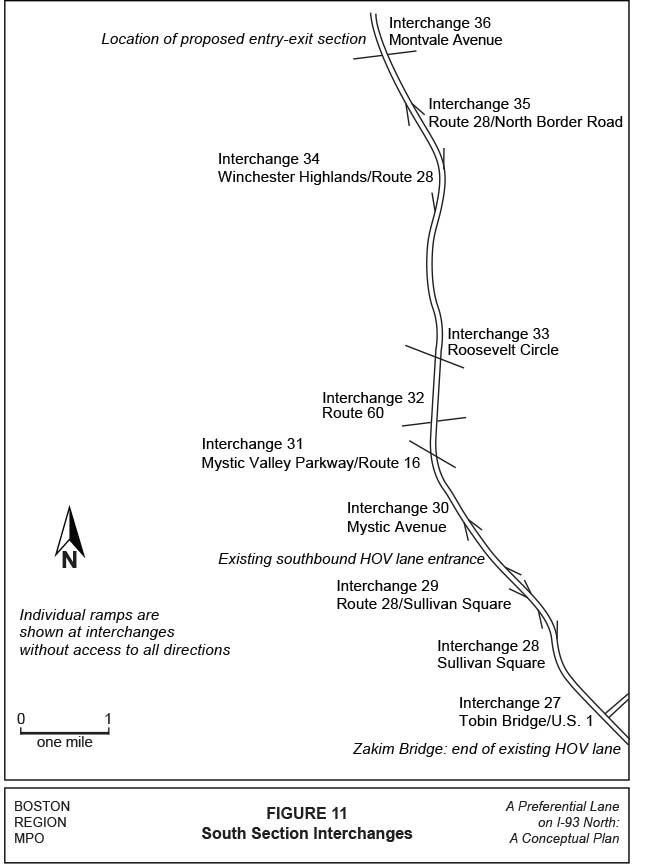
Some of the conditions and nearby features that would influence any reconstruction of I-93 are summarized in this section. These issues are presented starting at the south end of the project because the design constraints in this area are most clearly defined.
Throughout the 18 miles of the proposed preferential lane system, I-93 crosses over a roadway, river, or railroad at 24 locations, which are listed in Table 4. The expense of adding at least 24 additional feet of roadway width throughout the corridor would include the cost of widening these structures.
There are also 15 roadway structures under which I-93 passes in this corridor, also listed in Table 4. Full, or in some instances partial, reconstruction would be necessary for all 15 of these existing structures. Not only would the full or partial reconstruction of these bridges entail significant expense, but the design of the reconstructed bridges is integral to the design of the preferential lane system itself. Even if a bridge were to be reconstructed near the end of its useful life but well before construction of the reversible lane, the alignment of the future reversible lane needs to be known and reflected in the design of the reconstructed bridge. Some relocation of the general-purpose travel lanes could also be necessary in the vicinity of a reconstructed bridge.
The challenge of re-using part of an existing bridge is illustrated with the example of the Salem Street bridge in Woburn, whose age and condition are typical within this corridor. Figure 13 shows this bridge looking north, less than a mile north of Interchange 36/Montvale Avenue—the location of an associated entry-exit section. Like most bridges in the preferential lane corridor, Salem Street would cross the reversible lane itself rather than an entry-exit section. (Note that the breakdown lane has been pressed into service as an auxiliary lane.)
A future reversible lane like the one shown at the bottom of Figure 6 would be flanked by two general-purpose traffic barrels roughly the width of the northbound lanes shown in Figure 13. If the required widening of the highway at the location of a bridge could be achieved entirely on one of the two sides of
Table 4
Physical Features Crossing I-93
in the Proposed Preferential Lane Corridor
| Interchange | Physical Feature | I-93 Crosses | |
|---|---|---|---|
| 42 | Dascomb Road | over | |
| Tewksbury freight rail line | over | ||
| Vale Street | over | ||
| Shawsheen River | over | ||
| Haverhill passenger rail line | over | ||
| 41 | Route 125 | under | |
| 40 | Route 62 | under | |
| Woburn Street | under | ||
| 39 | Concord Street | over | |
| Ipswich River | over | ||
| Haverhill passenger rail line | over | ||
| 38 | Route 129 | under | |
| West Street | under | ||
| 37C | Commerce Way on-ramp | under | |
| 37C | Commerce Way off-ramp | under | |
| Washington/West Street | over | ||
| 37 | I-95/Route 128 | over | |
| Salem Street | under | ||
| 36 | Montvale Avenue | over | |
| industrial driveway | over | ||
| Marble Street | under | ||
| 35 | Route 28 | over | |
| 34 | Fellsway West-Stoneham | under | |
| Fellsway West-Stoneham | over | ||
| Fellsway West-Medford | under | ||
| 33 | Roosevelt Circle WB | under | |
| 33 | Roosevelt Circle EB | under | |
| Fellsway West-Medford | over | ||
| Webster Street | over | ||
| 32 | Route 60 WB | over | |
| 32 | Route 60 EB | over | |
| Riverside Avenue | over | ||
| Mystic River | over | ||
| 31 | Mystic Valley Parkway | under | |
| Route 16 | over | ||
| 30 | Mystic Avenue on-ramp | under | |
| Shore Drive | over | ||
| Temple Street | over | ||
| 29 | Route 28 | over | |
FIGURE 13
Salem Street Bridge
View Looking North in the Northbound Lanes
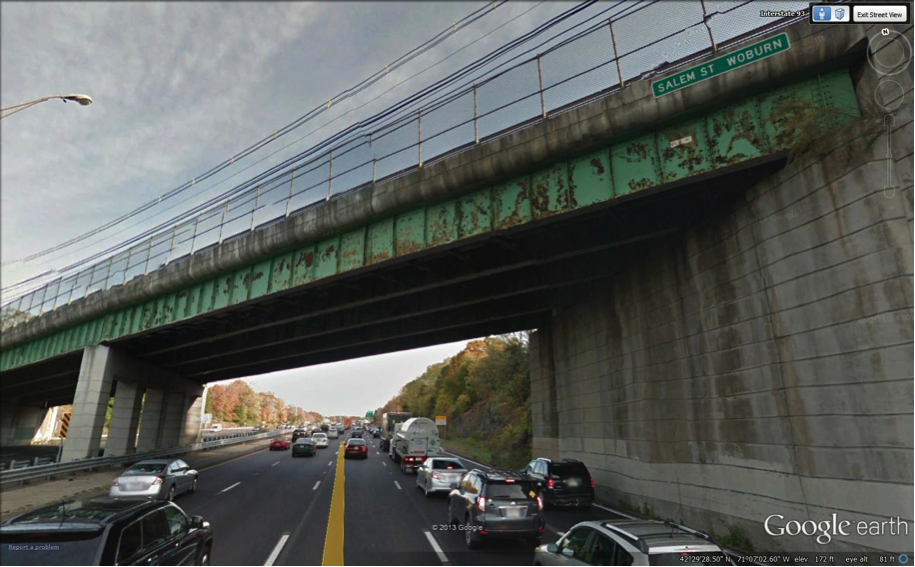
the highway, then it might be possible to keep the existing median bridge support and half of the bridge. Bridges might be partially reconstructed in this manner—with the widening construction extending either to the east or to the west—providing that the highway alignment can be suitably adjusted between partially reconstructed bridges.
If only one bridge support is utilized, the other span of the bridge would need to extend 90 feet to cross the four general-purpose lanes, the breakdown lane, and the new reversible lane. The wide span would be necessary if the bridge were being reconstructed before construction of the reversible lane in order to allow the existing general-purpose lanes to operate without an obstruction. If the bridge were being reconstructed at the same time as the reversible lanes, building a second bridge support in the other reversible lane barrier could be a practical bridge design alternative.
Interchange 37C was added to the I‑93 system in the 1990s. Because of its young age, proximity to Interchange 37, and impressive physical design, configuring the preferential lane system around this interchange requires considering all the design, feasibility, and construction issues that have been presented in this section. Figure 14 shows these modern viaducts from the perspective of looking away from I-95/Route 128 into the southbound traffic flow.
FIGURE 14
Interchange 37C
View Looking North in the Southbound Lanes
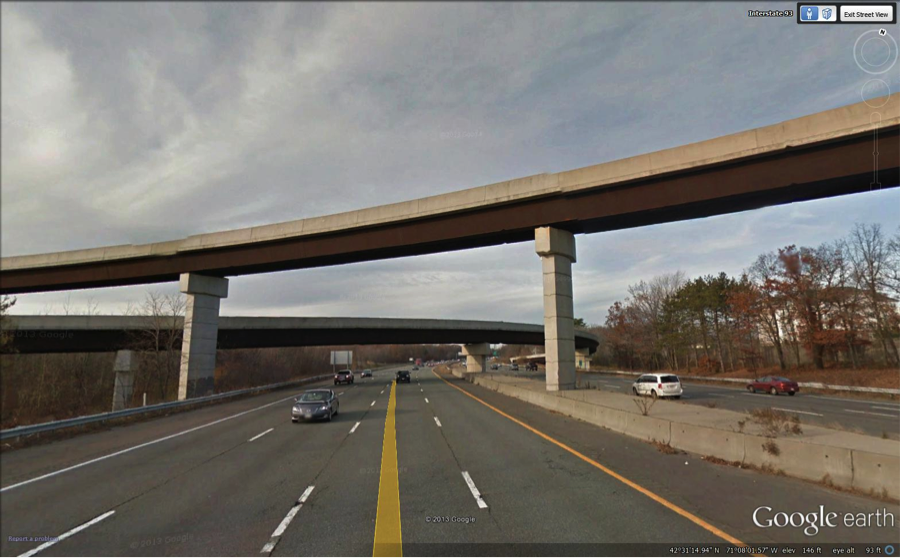
A narrow-corridor entry-exit section (see Figures 6 and 7) would be the simplest element of the preferential lane system to construct at Interchange 37C. Entry-exit sections have one concrete barrier at the centerline of the highway, and this interchange was constructed with enough spanned width that a pair of buffered entry-exit lanes could be added with the loss of perhaps only a few feet from the outside breakdown lanes. If, however, it is determined that the entry-exit section associated with this interchange should include a weave lane, then this wider entry-exit section would need to be pulled out from under these viaducts to avoid the viaducts’ complete reconstruction.
A lane reduction and resulting bottleneck at this location would be unacceptable, and if an entry-exit section cannot be built through this interchange, then the reversible lane would need to be constructed here. The northbound barrel would require no modifications, but a 90-foot span would need to be created in the southbound direction to accommodate the reversible lane, general-purpose lanes, and breakdown lane.
This required horizontal clearance could be created by constructing some type of replacement support structure for the viaduct in the foreground of Figure 14. This replacement structure would be at least 90 feet from the median, and once it was constructed, the existing support adjacent the breakdown lane could be demolished and the reversible lane constructed through this defile.
If the replacement support structure was built and the horizontal clearance increased, it would also be possible to set up a southbound entry-exit section under these viaducts that included a weave lane. The northbound entry-exit section would still need to be the narrow-corridor type to avoid the need for totally reconstructing the interchange.
A wide-corridor entry-exit section with a pair of weave lanes might be constructed directly north of the Interchange 37C viaducts. In this location, traffic from the northbound preferential lane exiting at Interchange 38/Route 129 would have about 1,200 feet of weaving distance per lane. Southbound traffic entering at Interchange 38 would have 1,000 feet of weaving distance per lane available for entry to the central reversible lane section. Weaving distances between the north reversible lane section and Interchange 37/I-95/Route 128 would exceed 1,600 feet per lane. If the entry-exit section were located further north, weaving distances to Interchange 38 would decrease, but weaving distances to Interchange 37 would increase.
If a wide-corridor entry-exit section is constructed directly south of the Interchange 37C viaducts, southbound preferential lane traffic exiting at Interchange 37/I‑95/Route 128 would have about 1,200 feet of weaving distance per lane. Northbound traffic entering at Interchange 37 would have 1,300 feet of weaving distance per lane available for entry to the north reversible lane section.
As suggested by the calculations in Table 3, the entry-exit sections could be located even further from Interchange 37C while still allowing more than 650 feet per lane change for vehicles accessing the system at the nearby usable interchanges. Note that with the entry-exit section constructed outside of Interchange 37C, unsafe access to or from the interchange must be precluded, and Interchange 37C must be modified sufficiently to allow inclusion of the reversible lane in the I-93 corridor.
Unlike the proposed new reversible lanes whose eventual locations would emerge from the process of identifying or acquiring additional usable right-of-way, the location of the proposed exit-only lane to Interchange 28/Sullivan Square is already determined. Figures 15 and 16 show the south end of the embankment and the viaduct on the final approach to the exit at Interchange 28 viewed from Mystic Avenue.
FIGURE 15
Embankment Approaching Interchange 28/Sullivan Square Exit
View Looking North from Mystic Avenue

FIGURE 16
Viaduct Approaching Interchange 28/Sullivan Square Exit
View Looking South from Mystic Avenue

Adding a lane of roadway surface on the embankment and widening the viaduct could be accomplished within the transportation corridor. However, bringing traffic 12 feet closer to the mixed-use activities on Mystic Avenue would be an impact that would need to be evaluated and potentially mitigated.
A key premise of the Phase I Study was that gradually increasing traffic congestion imposed both economic and quality-of-life burdens on the region. Congestion relief strategies do not include the construction of new express highways, and the widening of express highways is only being considered in a few specific locations. The proposed reversible lane would be a lane addition and would require state regulatory relief as well as full state and federal regulatory review.
The implementation of HOV lanes is considered a viable regional strategy to relieve congestion and accommodate long-range traffic growth. Three HOV lane segments currently operate at different locations on I‑93. These initial implementations are considered successful and expansion of their scope and capabilities have been examined in this and earlier studies.
Adding some sort of HOV facility in I-93 north of Boston beyond its existing southbound-only entrance in Somerville is not a new idea. It was a recommendation of the 1994 Feasibility Study, and the Phase I Study found that I-93 was suitable for preferential lane implementation throughout its length in Massachusetts north of Boston. As a consequence of traffic growth over the past two decades, implementing any preferential-lane design north of the existing HOV lane most likely would entail more highway reconstruction than was deemed necessary in 1994, when traffic levels would have allowed use of a moveable barrier system.
The regional travel demand model predicts that the investments described in this study could result in traffic on I-93 in 2035 enjoying a level of service comparable to that of 2012, despite long-term population, employment, and traffic growth trends. The BRT services that could be developed around a preferential lane system would offer commuters and other travelers north of Boston a set of attractive travel options not currently available.
Traffic analysis and model projections demonstrate operational feasibility at a planning level, with the proposed reversible lane attracting an appropriate number of users and providing meaningful benefits. The issue of physical feasibility is addressed in this study by presenting certain design standards and discussing the opportunities and challenges of implementing a preferential lane system that adheres to these standards throughout the length of the corridor. Bringing the plan to a level where a design could be recommended and costs estimated would require several steps:
The comments by MassDOT and its I-93/I-95 project consultant also emphasize these four points. Specific concerns and suggestions would be part of the next phase of study.
The envisioned preferential lane system would require reconfiguration and reconstruction of more than 18 miles of I-93. This study highlights a number of physical features and design issues that would affect this extensive rebuilding. Expansion of this information into a complete conceptual plan would be an appropriate step and would begin the process of preparing I-93 for the future.
WSK/wsk
February 26, 2014
The Highway Design Section has reviewed the design portion of the subject study report prepared by CTPS.
The study focuses on I-93 north of Boston, and proposes a new preferential lane system that would function as an extension of the existing north-side HOV facility as far north as Interchange 43 at Route 133 in Andover, a little more than a mile south of I‑495. The recommended configuration would be to add a reversible lane in the median of an existing highway while keeping the same number of general-purpose lanes. There would be breakdown lanes for the general-purpose and reversible lane.
Three preferential lane sections are proposed: northern, central, and southern. These three reversible lane sections are envisioned to be fully separated from adjacent general-purpose lanes. Vehicles using the preferential lane system will only be able to enter or exit at the ends of the three sections.
We offer the following comments:
Cross-Section Width for Reversible Lane
Northern Section
The Study proposes this section to be located within the cloverleaf ramps of Route 133/I-93 Interchange. There could be some signing & safety concerns due to multiple ramps at cloverleaf interchange. We are suggesting to locate this northern Entry-Exit section 4000’ south of the Route 133 bridge.
Central Section
The Study proposes an Entry-Exit Section within the Commerce Way / I-93 Interchange. This section seems to be located directly under two fly-over bridges. The cross section width under these bridges is not enough to accommodate Entry-Exit Section. We are suggesting to locate this section immediately south of the southern flyover bridge.
The existing I-93 bridge over I-95 will not be reconstructed as part of the reconstruction of this Interchange. The current cross-section on I-93 bridge consists of 40’ wide median. The left shoulder width for general purpose lanes would be only 4’ instead of 10’.
Southern Section
The Study proposes this section within the cloverleaf ramps of Montvale Avenue/ I‑93 Interchange. There could be some signing and safety concerns due to the multiple ramps at cloverleaf interchange. There would be two weaving operations happening at this location. This location does not seem be the ideal location. However, there are no other suitable locations available nearby. So, the design of this section would require special attention.
Bridges
Retaining Walls
Right-of-Way Issues
Environmental Issues
Cost
As stated earlier, our comments are focused on design-related issues. We are not commenting on other components of the study such as user benefits.
If you have any questions regarding this review comments, please contact me at 857-368-9443.
Hasmukh (Hardy) Patel, PE, Location Engineer/VE Coordinator

Highway Design
10 Park Plaza, Room 6260, Boston, MA 02116
Ph. 857-368-9443
Date: March 5, 2014
To: Ed Hollingshead
From: Rick Azzalina
Re: A Preferential Lane on I-93 North: A Conceptual Plan
FST Review Comments
Sections 1 and 2: Introduction and Background
Comments
Section 3: A Preferential Lane System for I-93
Comments
Section 4: Estimating User Benefits
Section 5: Design Standards, Feasibility and Construction Issues
Comments
(Proposed flyover ramps require modification to support piers – similar to 37C)
Comment
Comments
Section 6 Conclusion
Comments
1 Screening Regional Express Highways for Possible Preferential Lane Implementation, Boston Region MPO, 2012.
2 Improving the Southeast Expressway: A Conceptual Plan, Boston Region MPO, 2012.
3 Code of Massachusetts Regulations 310 CMR 7.37 High Occupancy Vehicle Lanes.
4 High Occupancy Vehicle Feasibility Study: Interstate 93 from I-95/Route 128 to the Charles River Crossing, MassHighway, 1994.
5 Historical Trends: Travel Times and Vehicle Occupancy Levels for I-93 North and Southeast Expressway HOV and General-Purpose Lanes, Boston Region MPO, 2012.
6 For further discussion of issues related to the Merrimack River Bridge see Appendix B, comments 4 and 5.
7 Comment 6 in Appendix B suggests that direct ramp connections merit further consideration.
8 The advantages of two alternate locations for the northern entrance of the preferential lane are presented in comment 2 of Appendix A, and comments 9 and 10 of Appendix B.
9 Possible modifications to interchange 37C and an alternative location for this entry-exit section are presented in comment 11 of Appendix B, and comment 3 of Appendix A.
10 See comment 4, Appendix A, and comments 21 and 22 of Appendix B for discussion of the proposed reconstruction of Interchange 37.
11 The entry-exit section at interchange 36 presents several difficult design challenges that are discussed in comment 5, Appendix A, and comment 12, Appendix B.
12 Comment 13 in Appendix B calculates weaving distances at the south end of the southern section and recommends that it be moved 500 feet north.
13 Massachusetts Regional Bus Study, Central Transportation Planning Staff, 2013.
14 A detailed description of bridge-reconstruction requirements is provided in comments 14 and 15 of Appendix B.
15 High-Occupancy Vehicle Facilities: A Planning, Design, and Operation Manual, Parsons Brinckerhoff Inc., 1990.
Priced Managed Lane Guide, FHWA Report FHWA-HOP-13-007, 2012.
These technical sources are used throughout this section.
16 Width requirements for an ultimate design might be either wider or narrower than this. See comment 1 of Appendix A, and comment 17 of Appendix B.